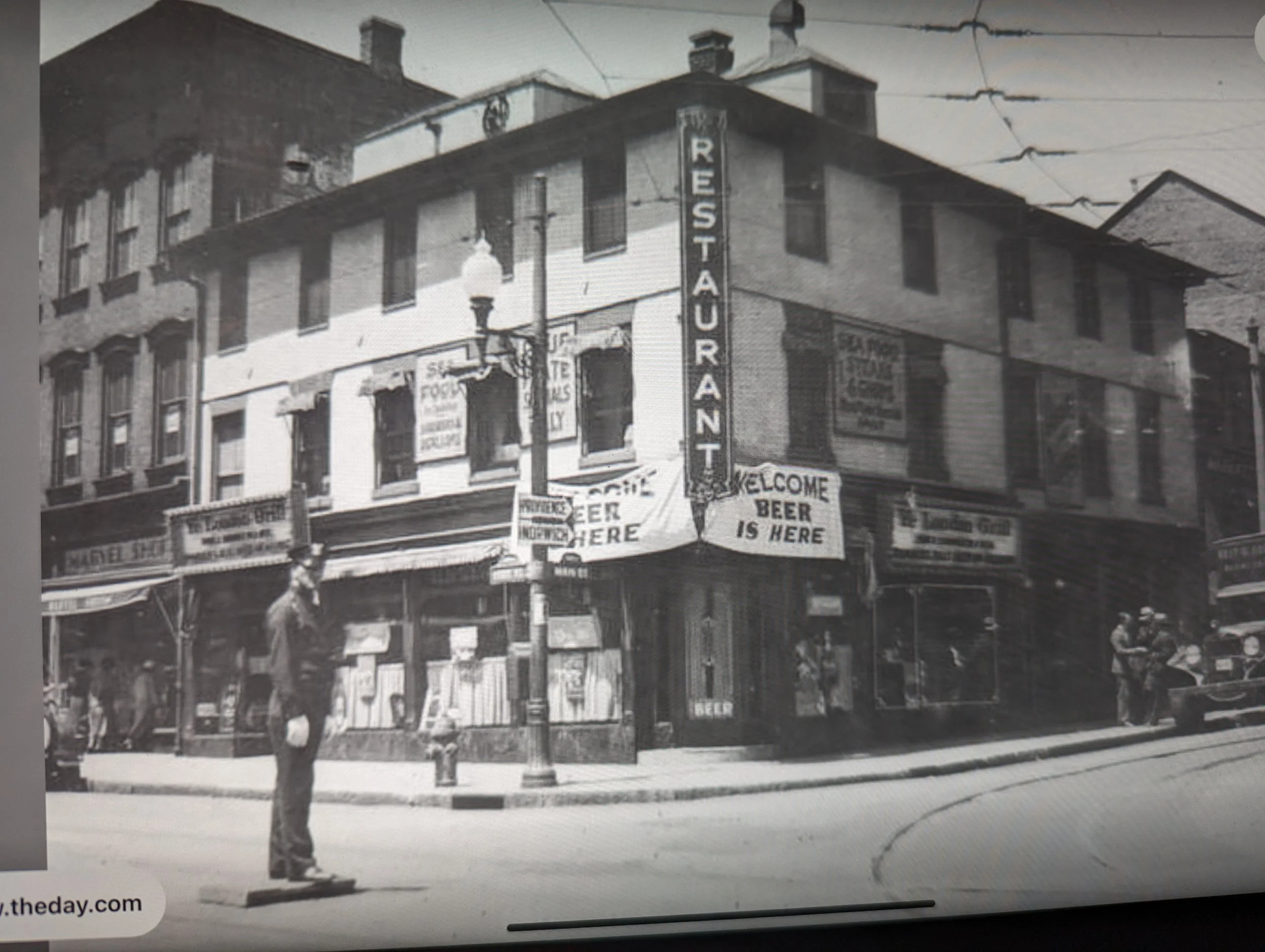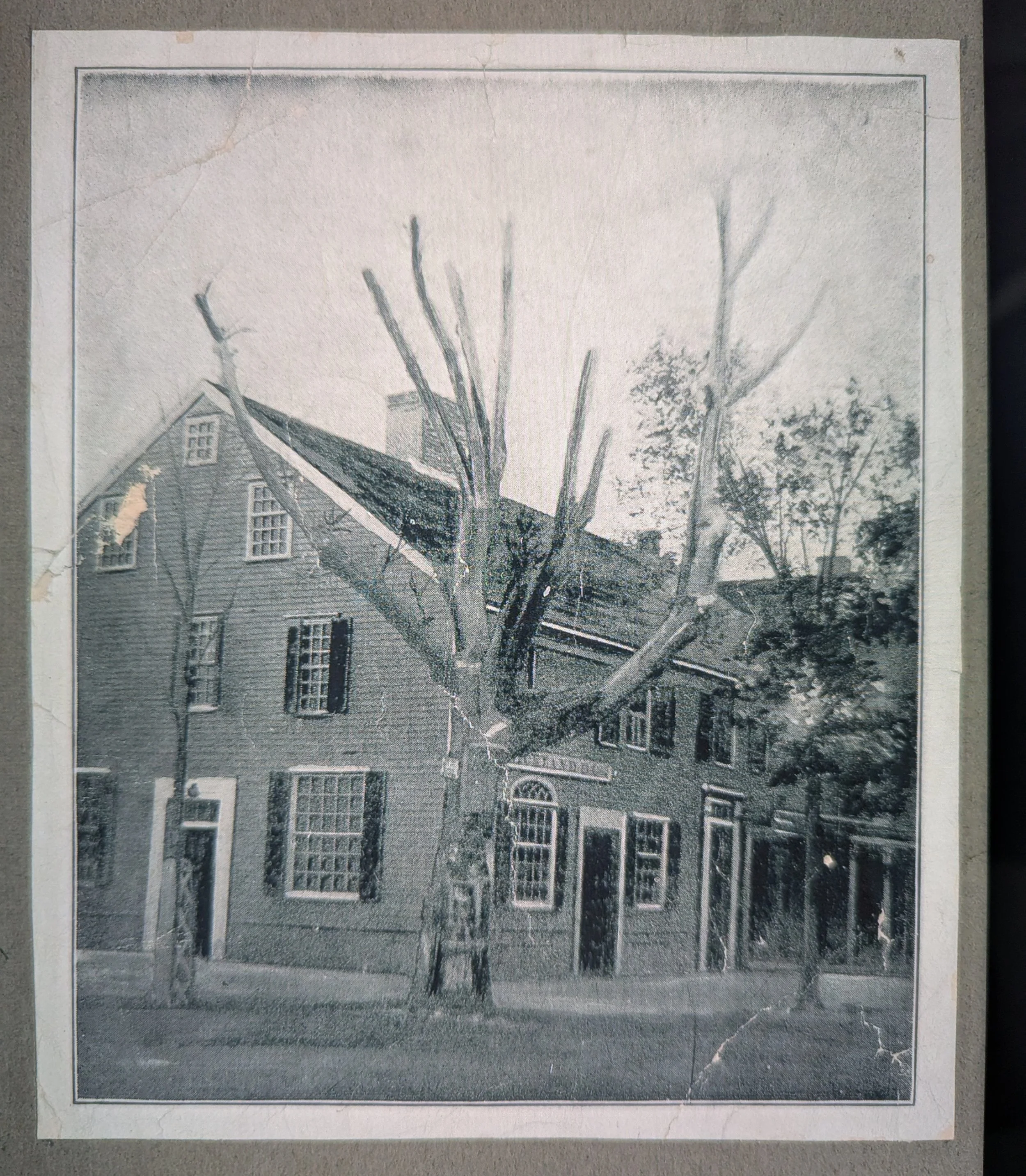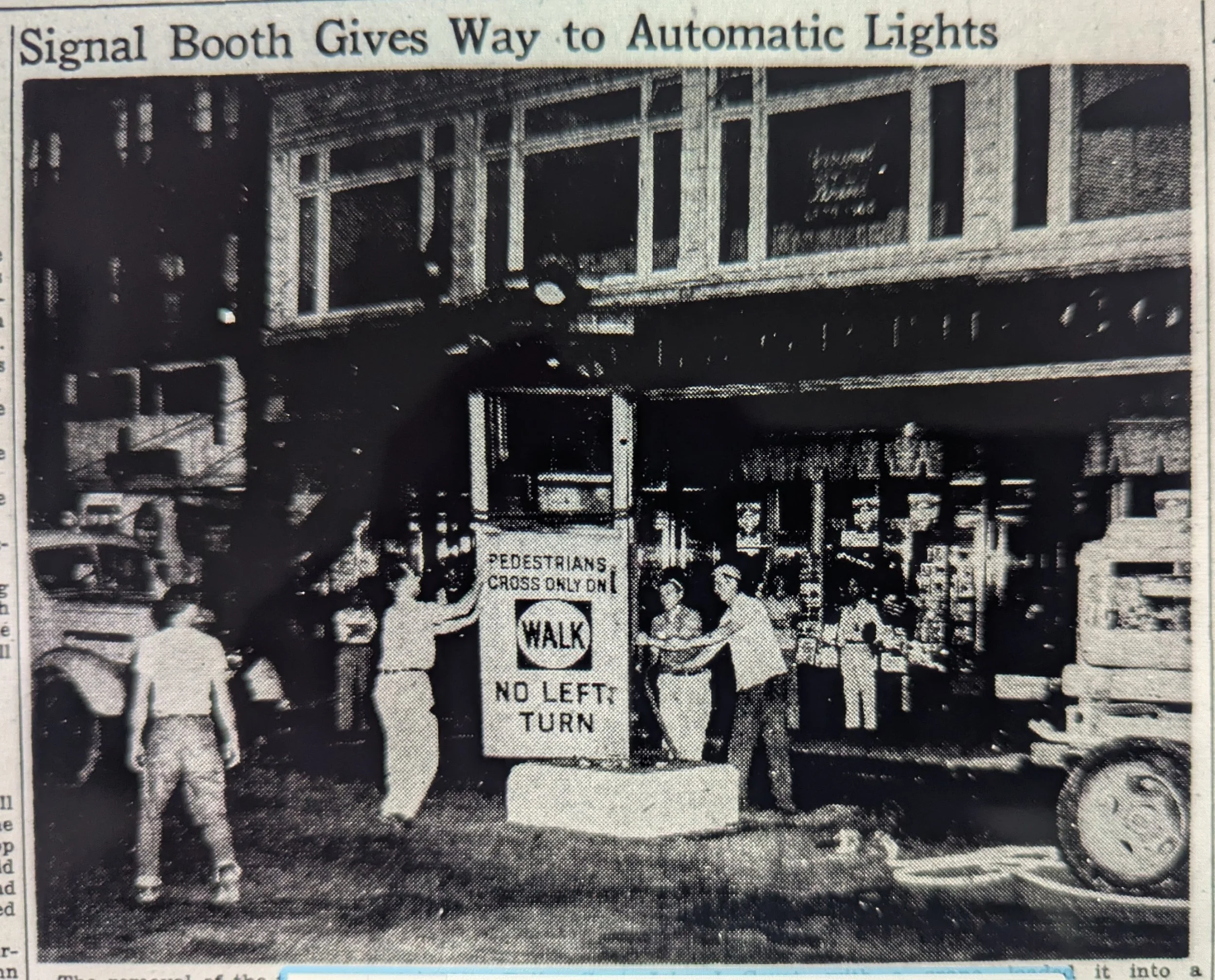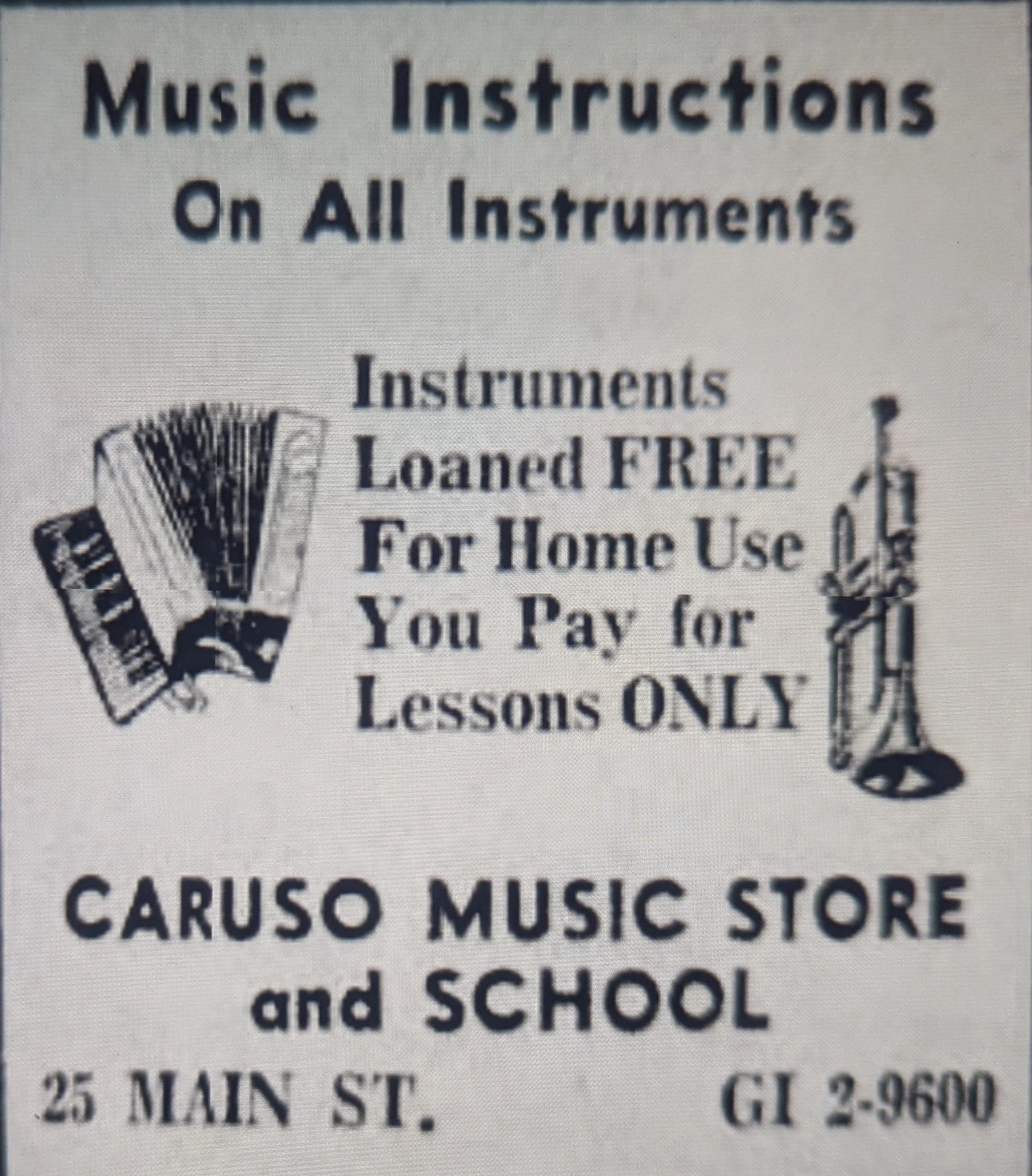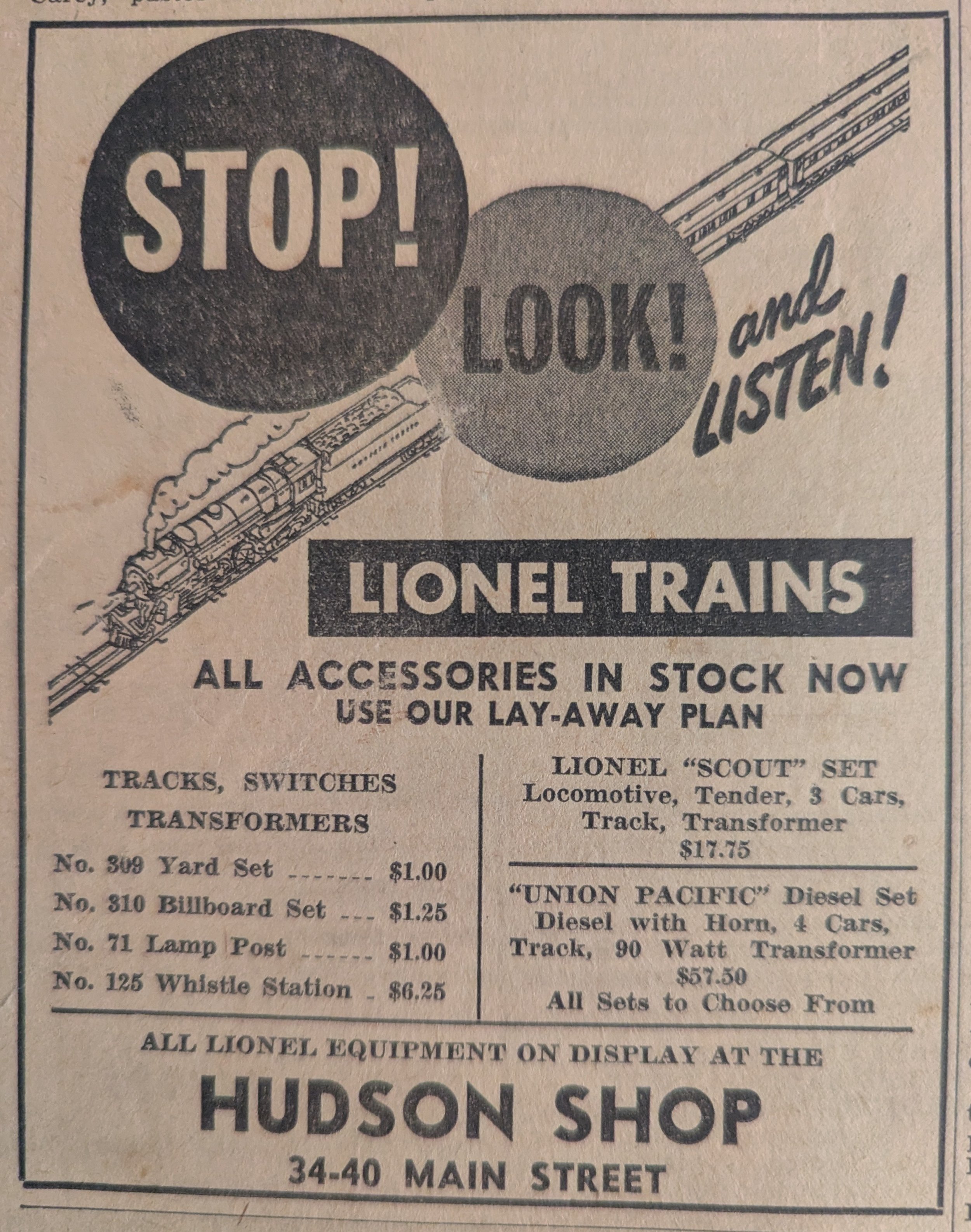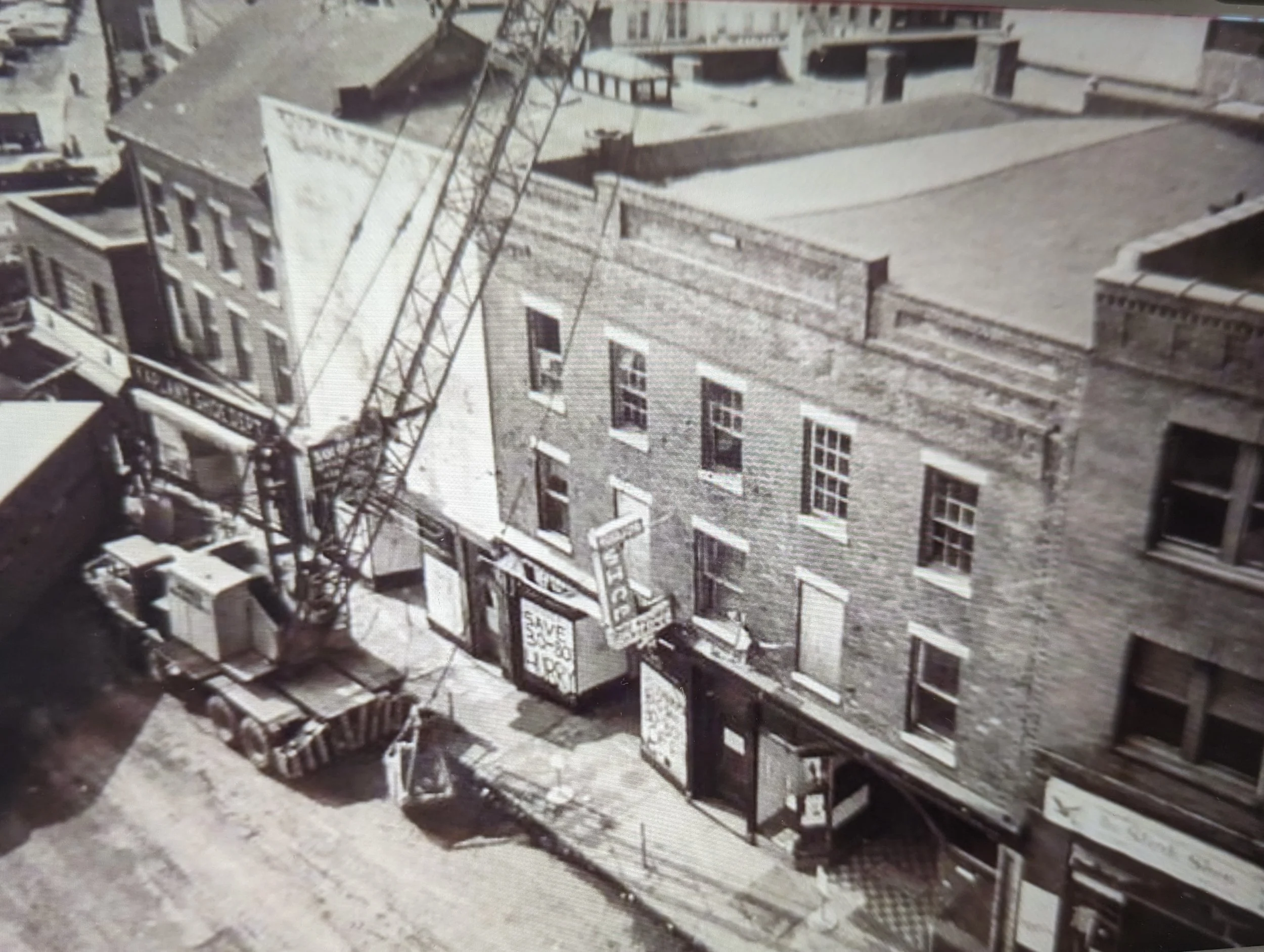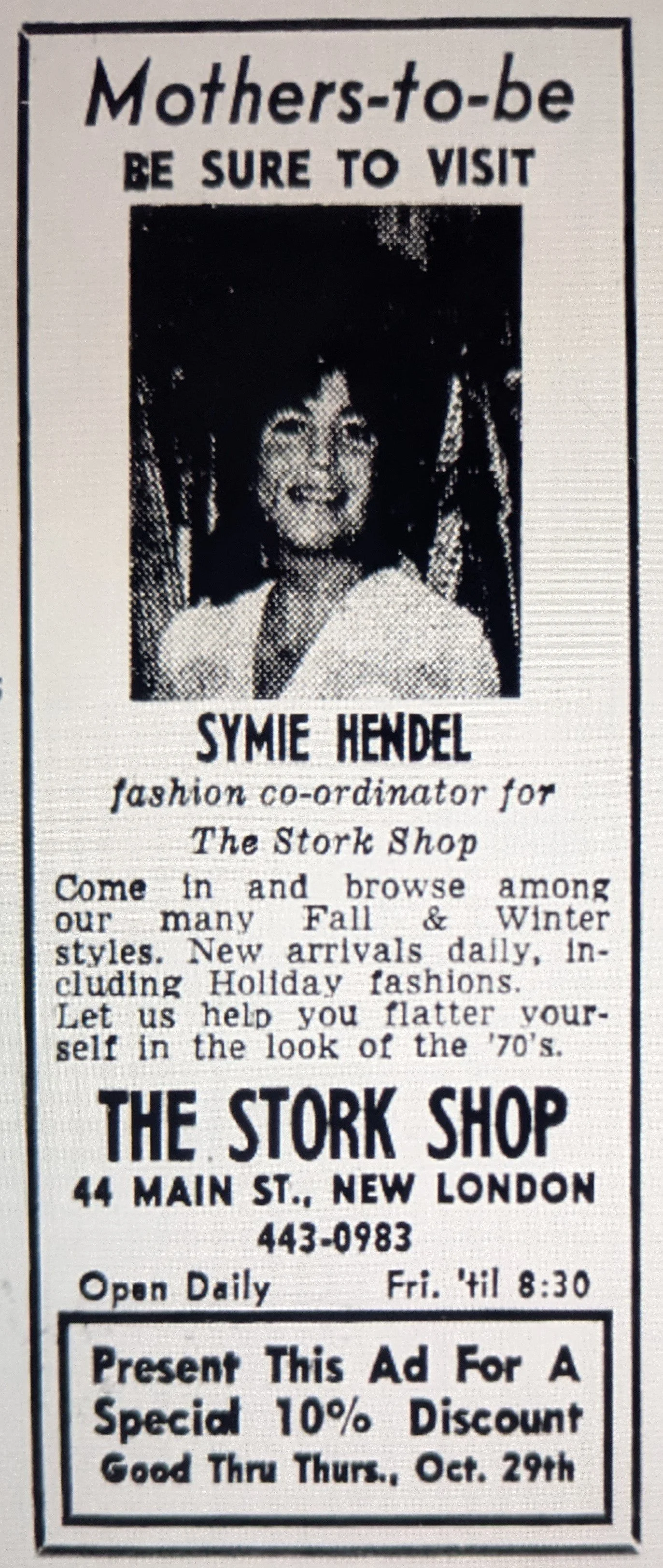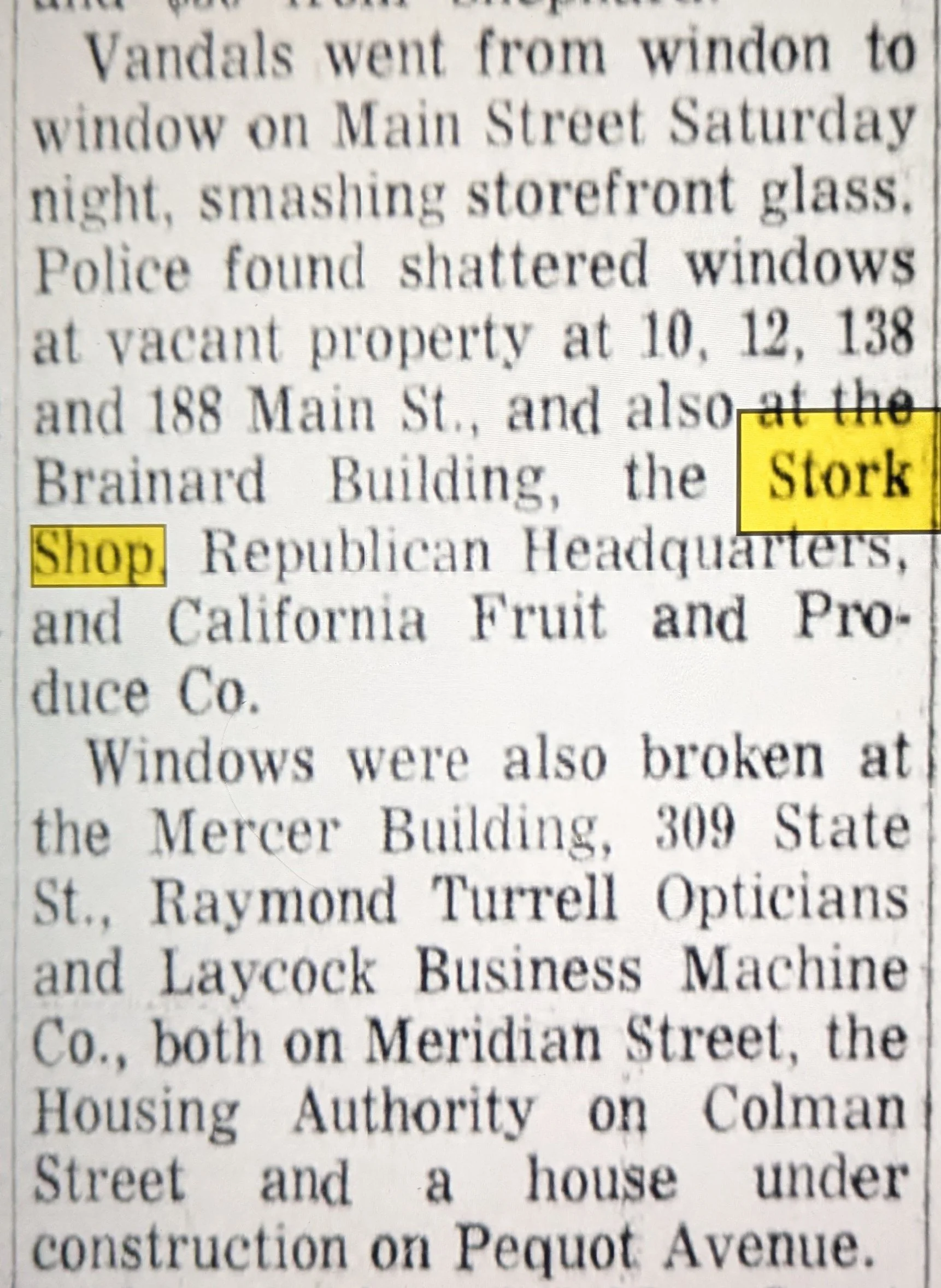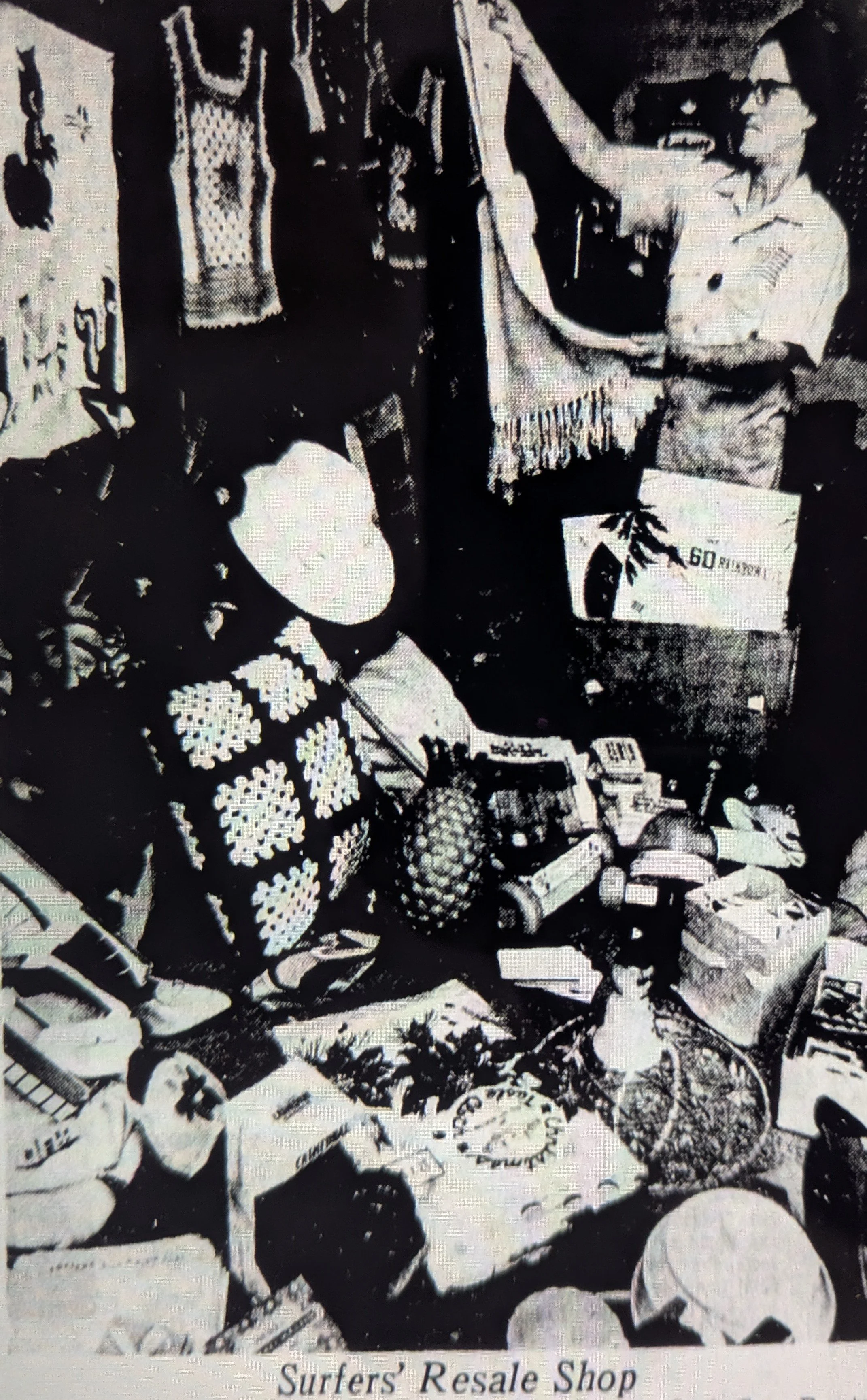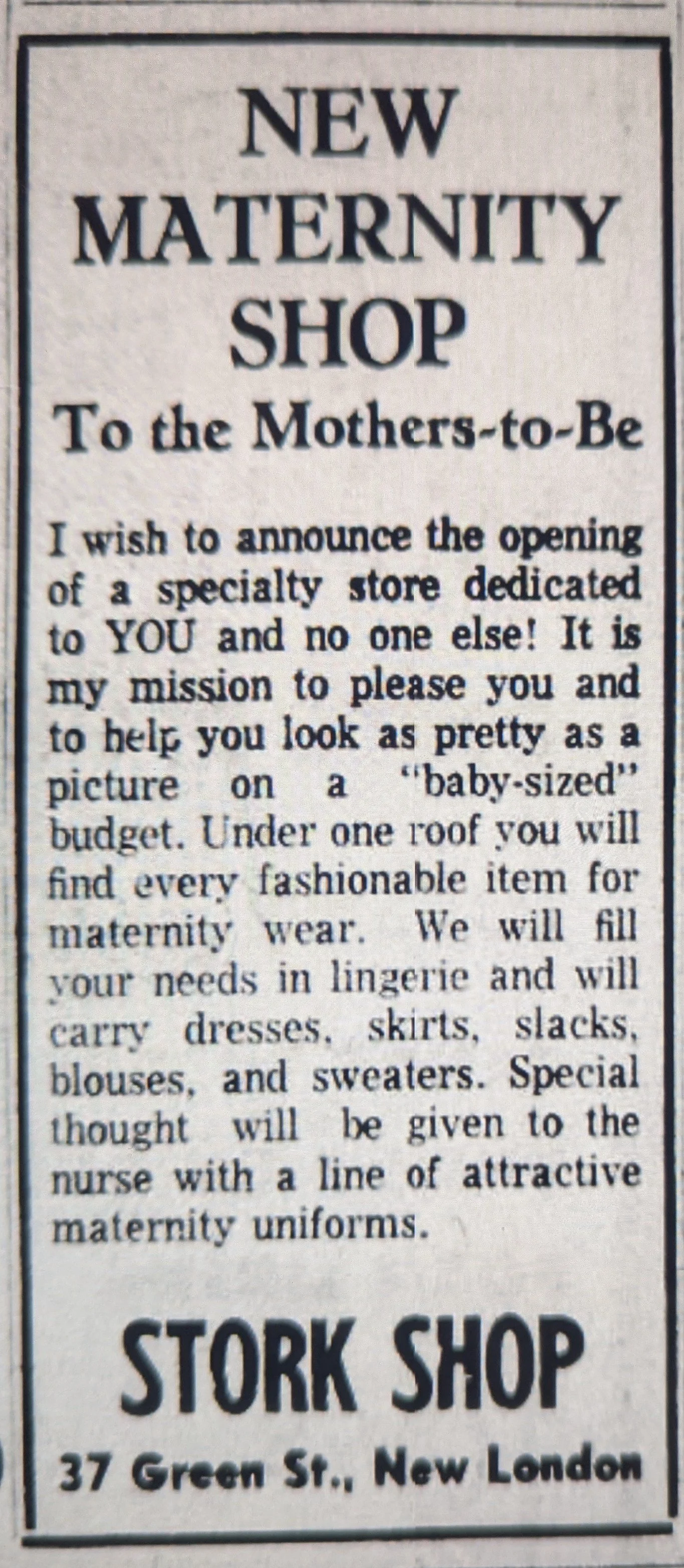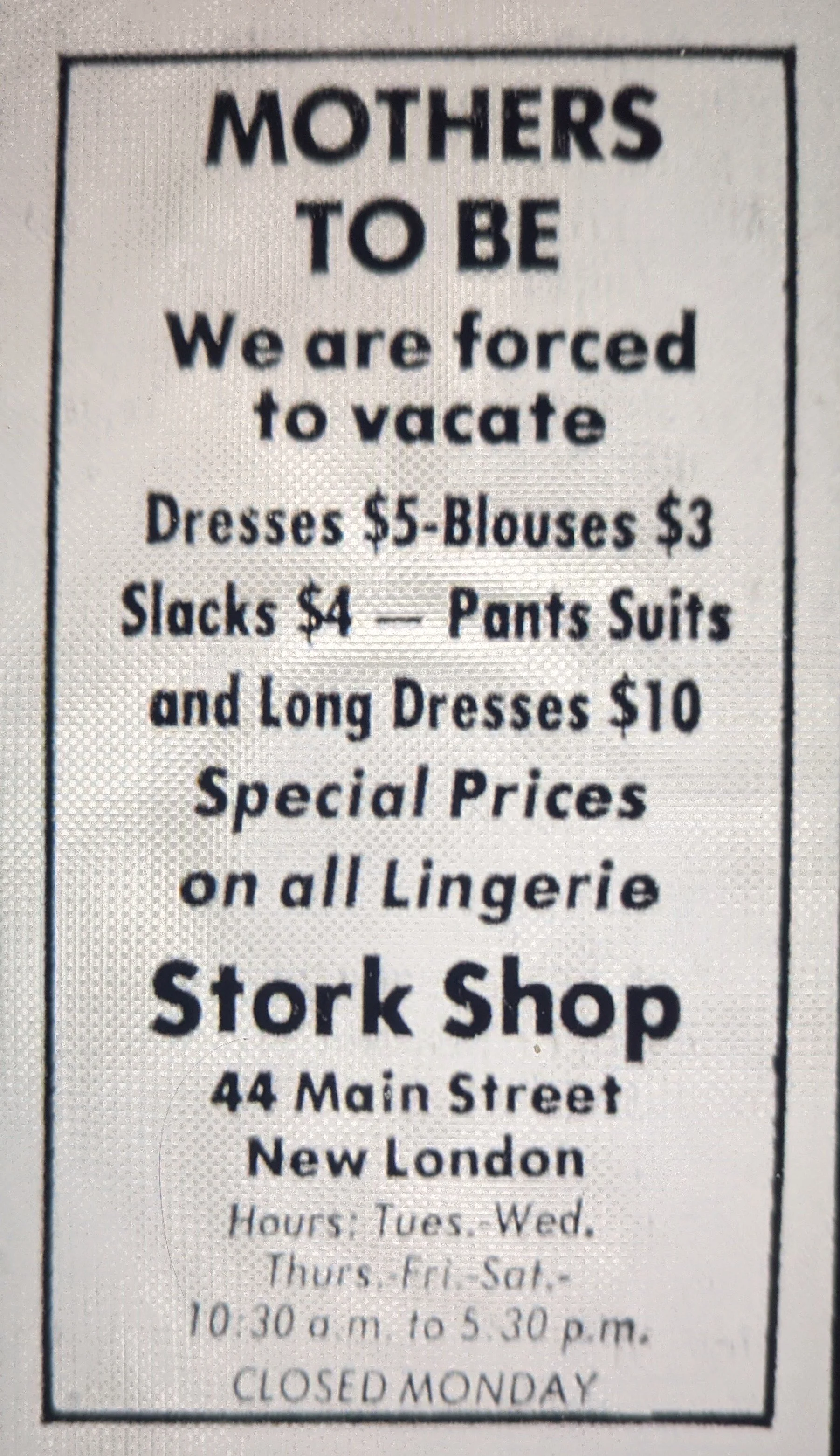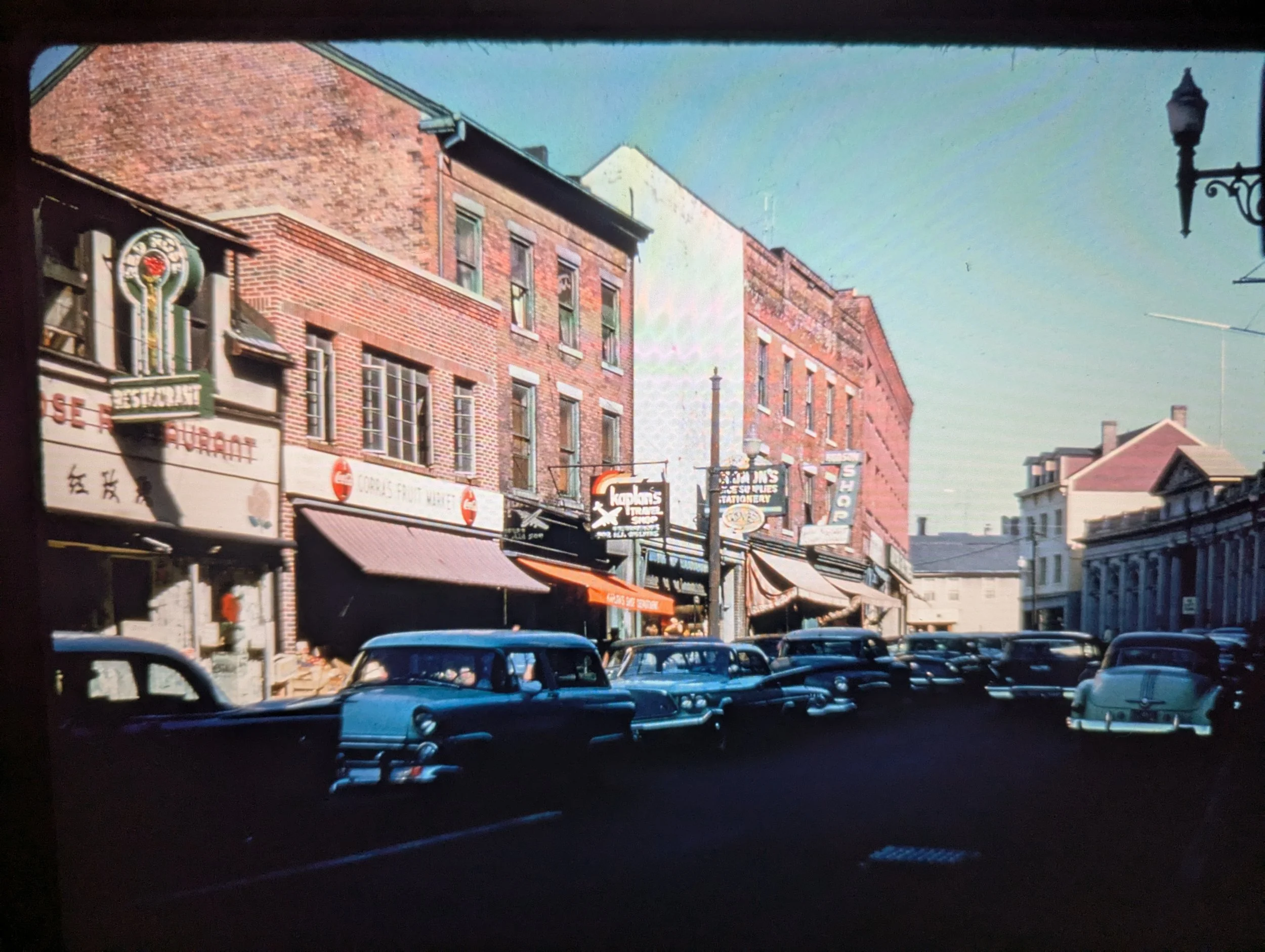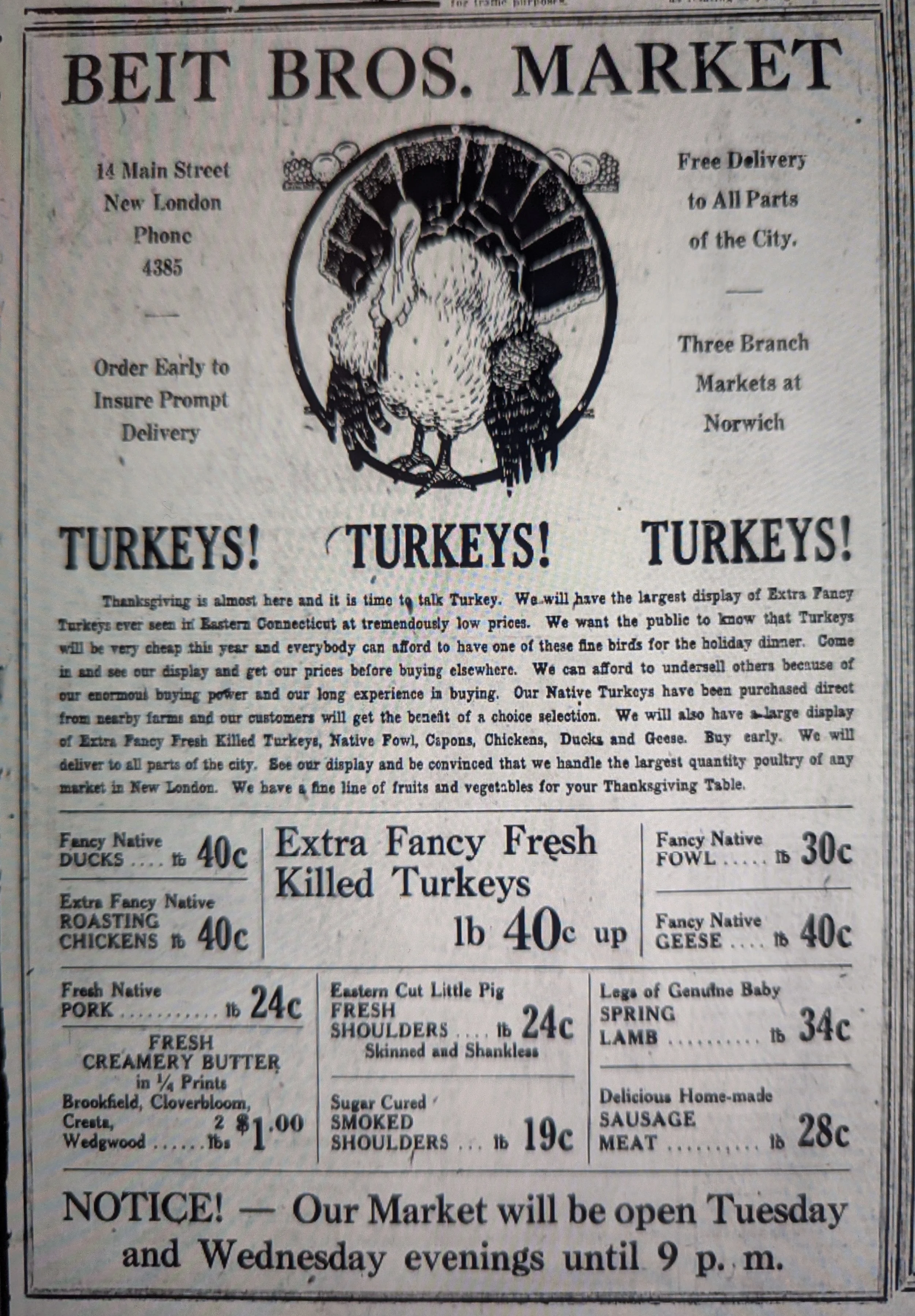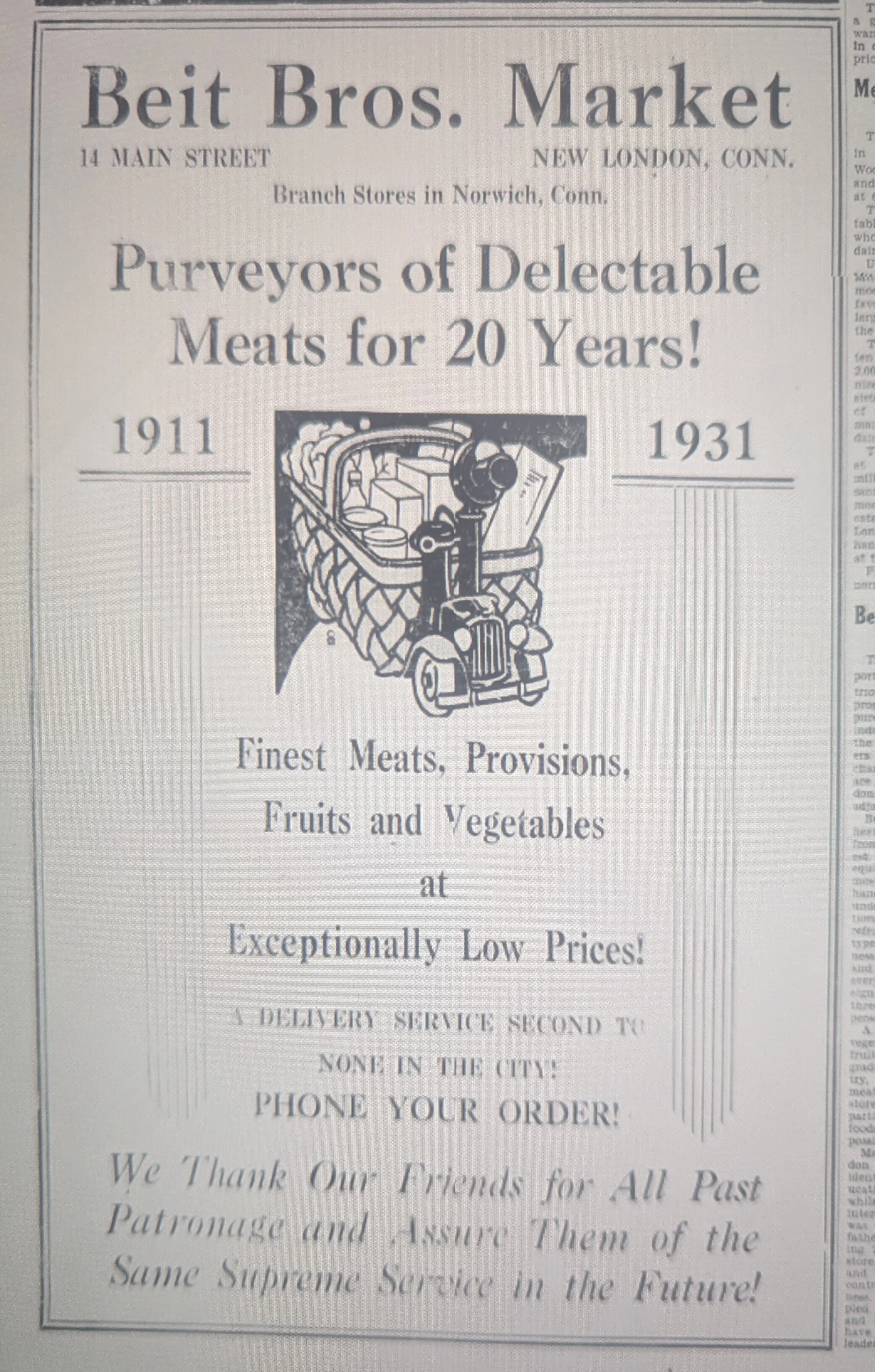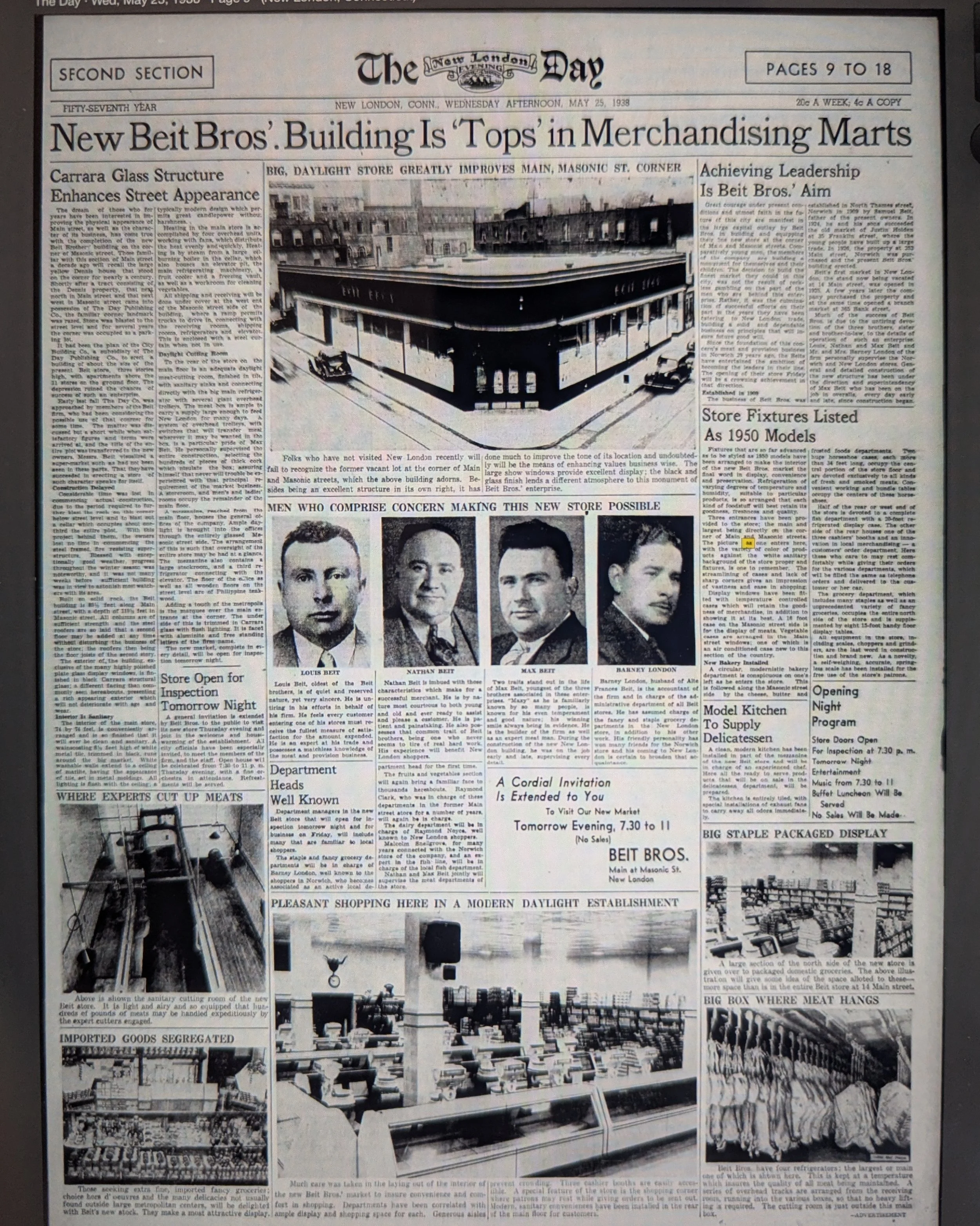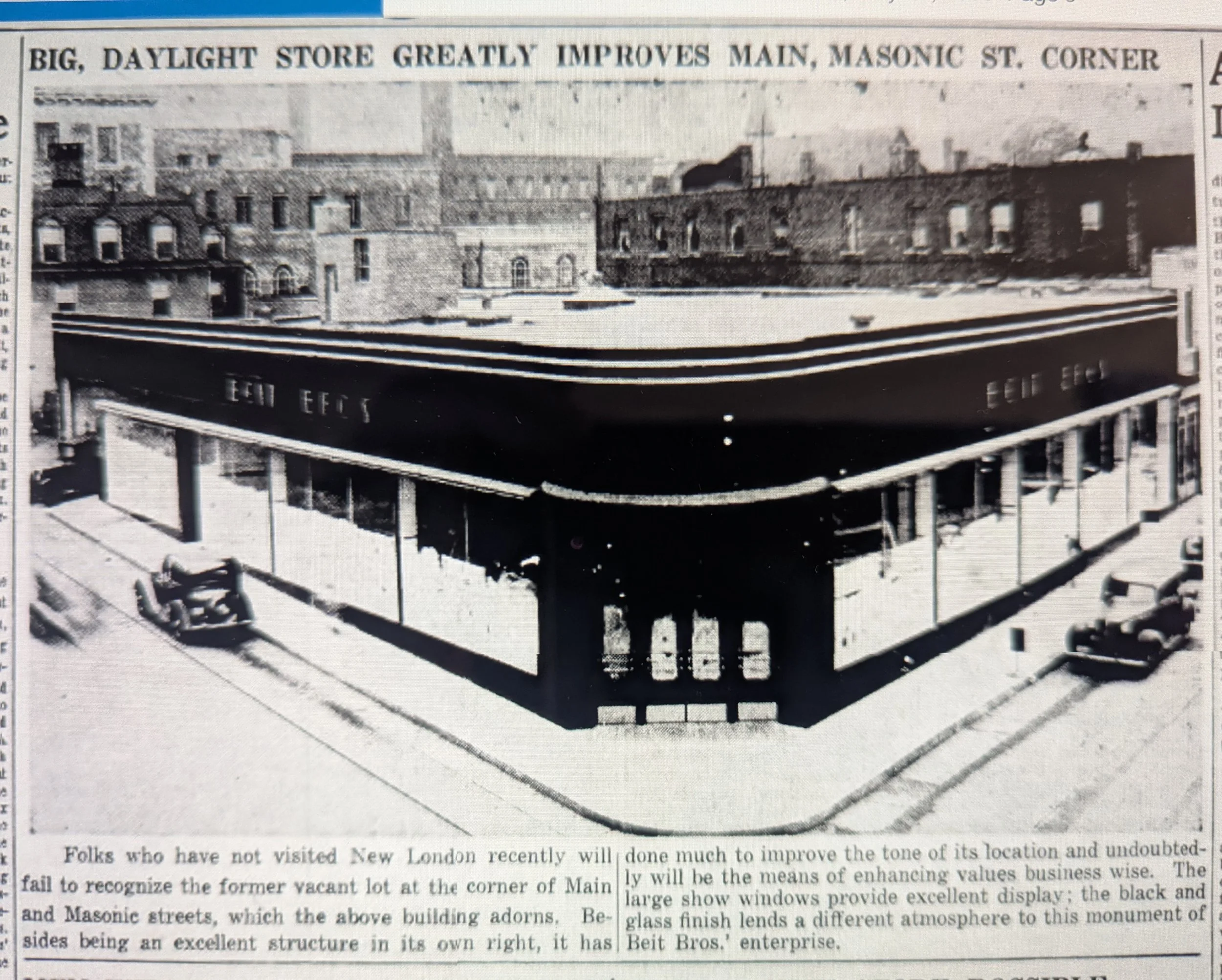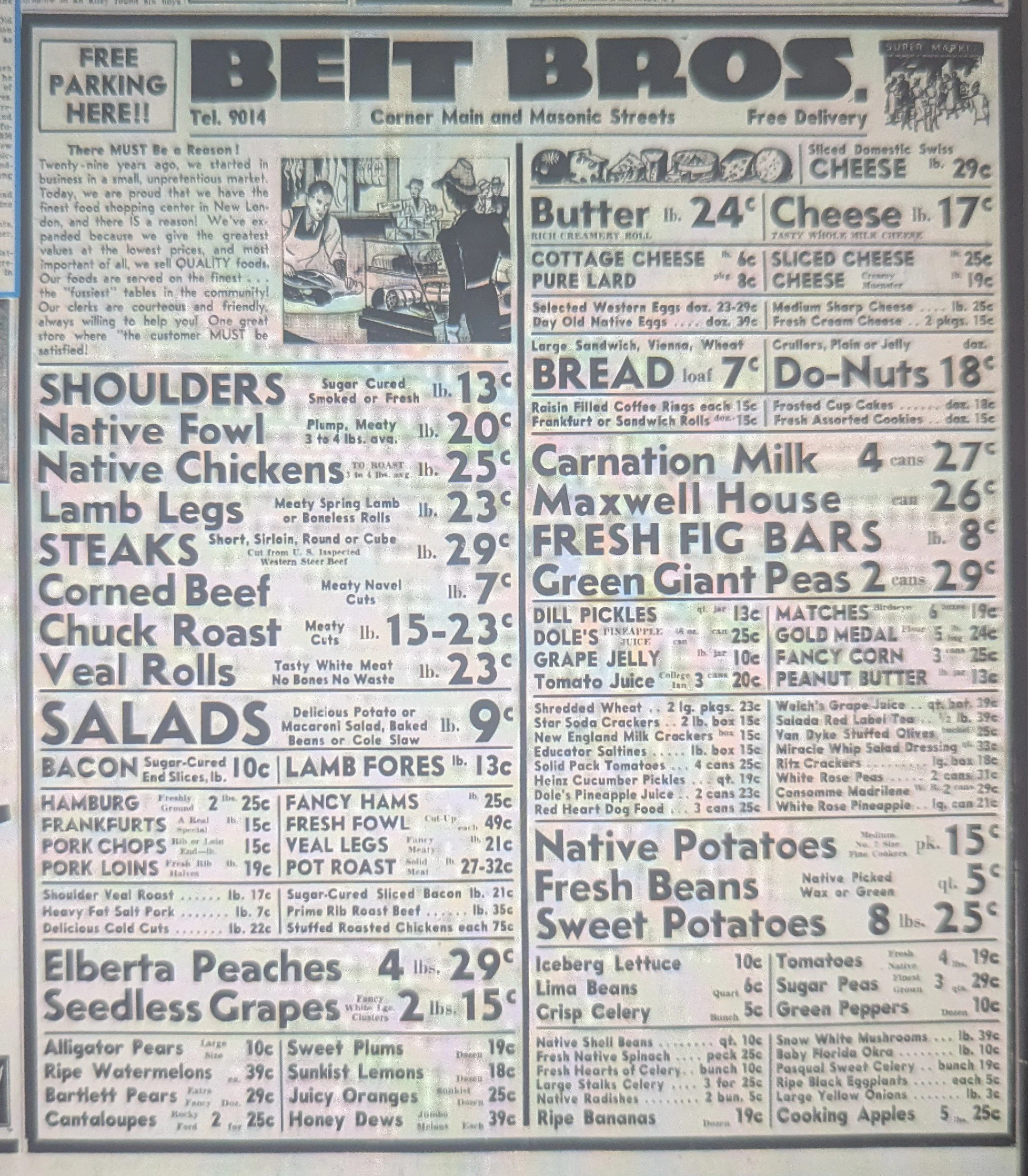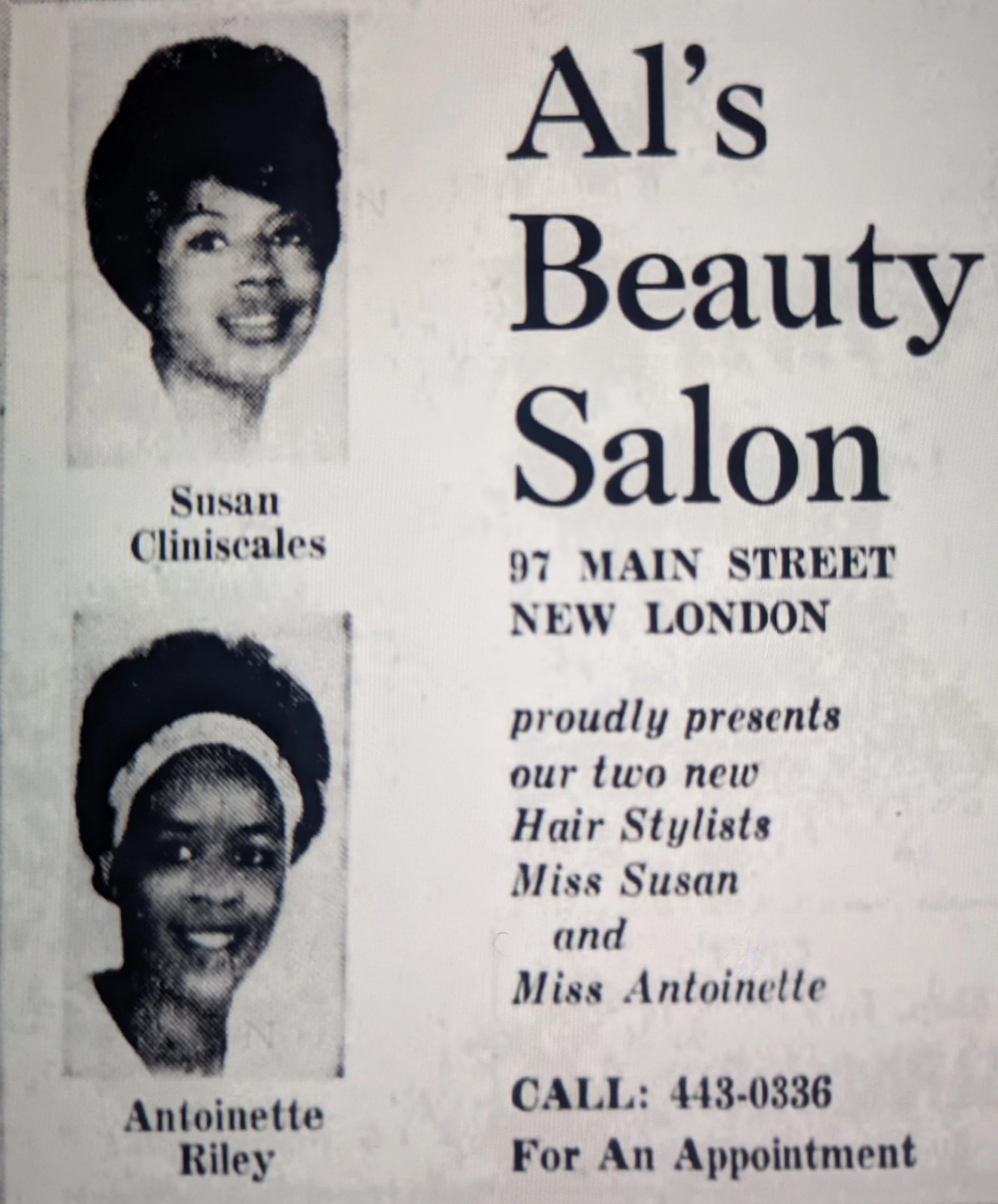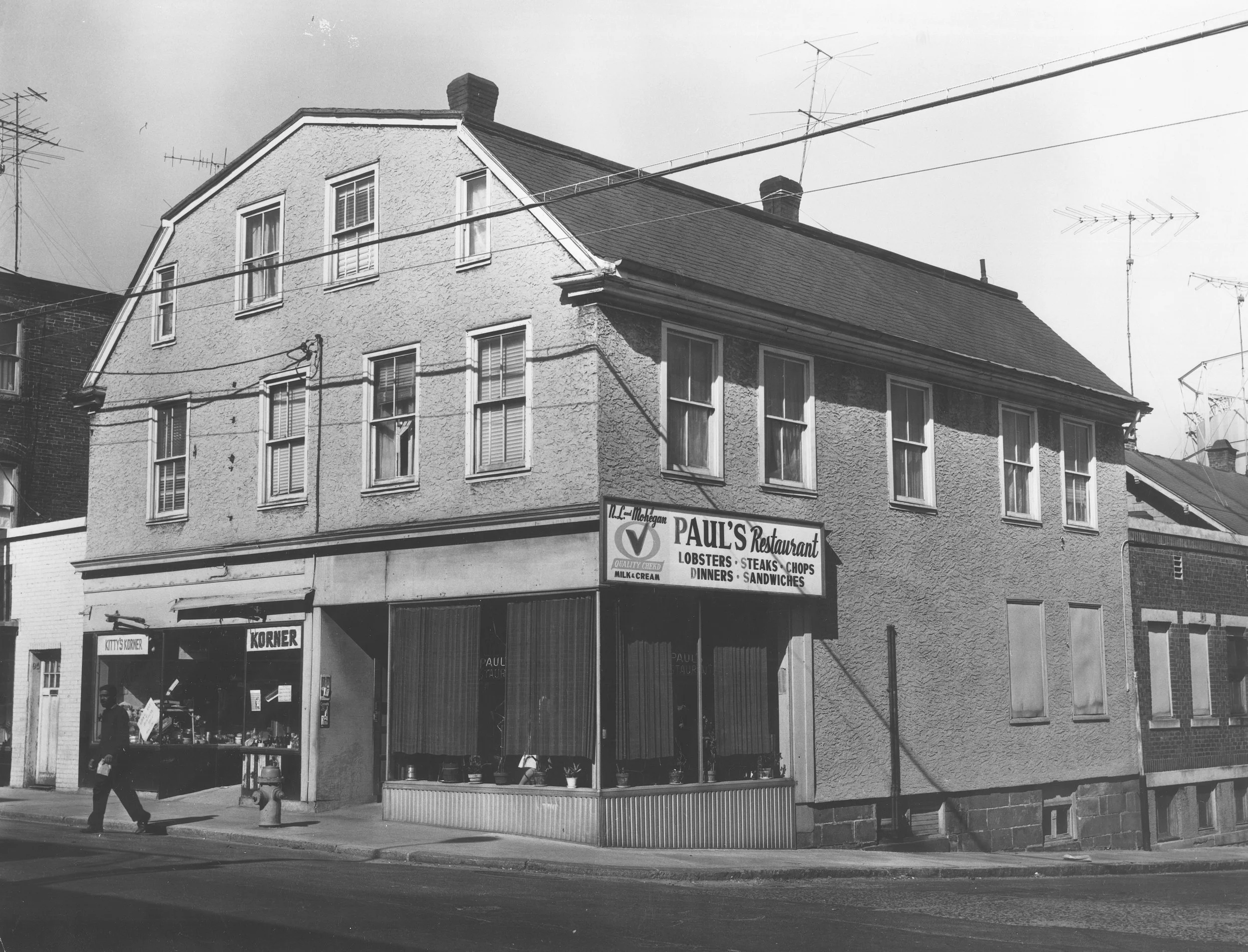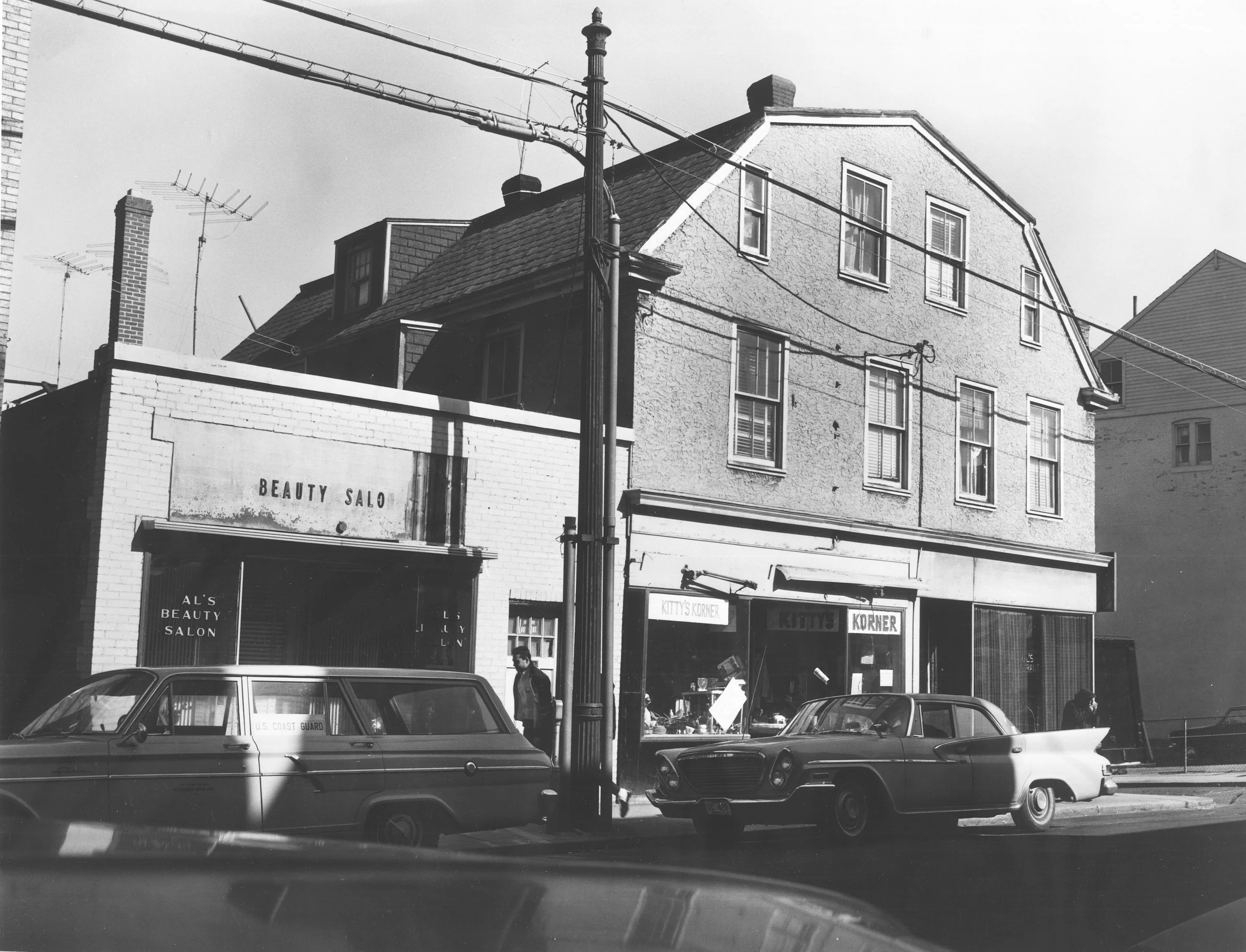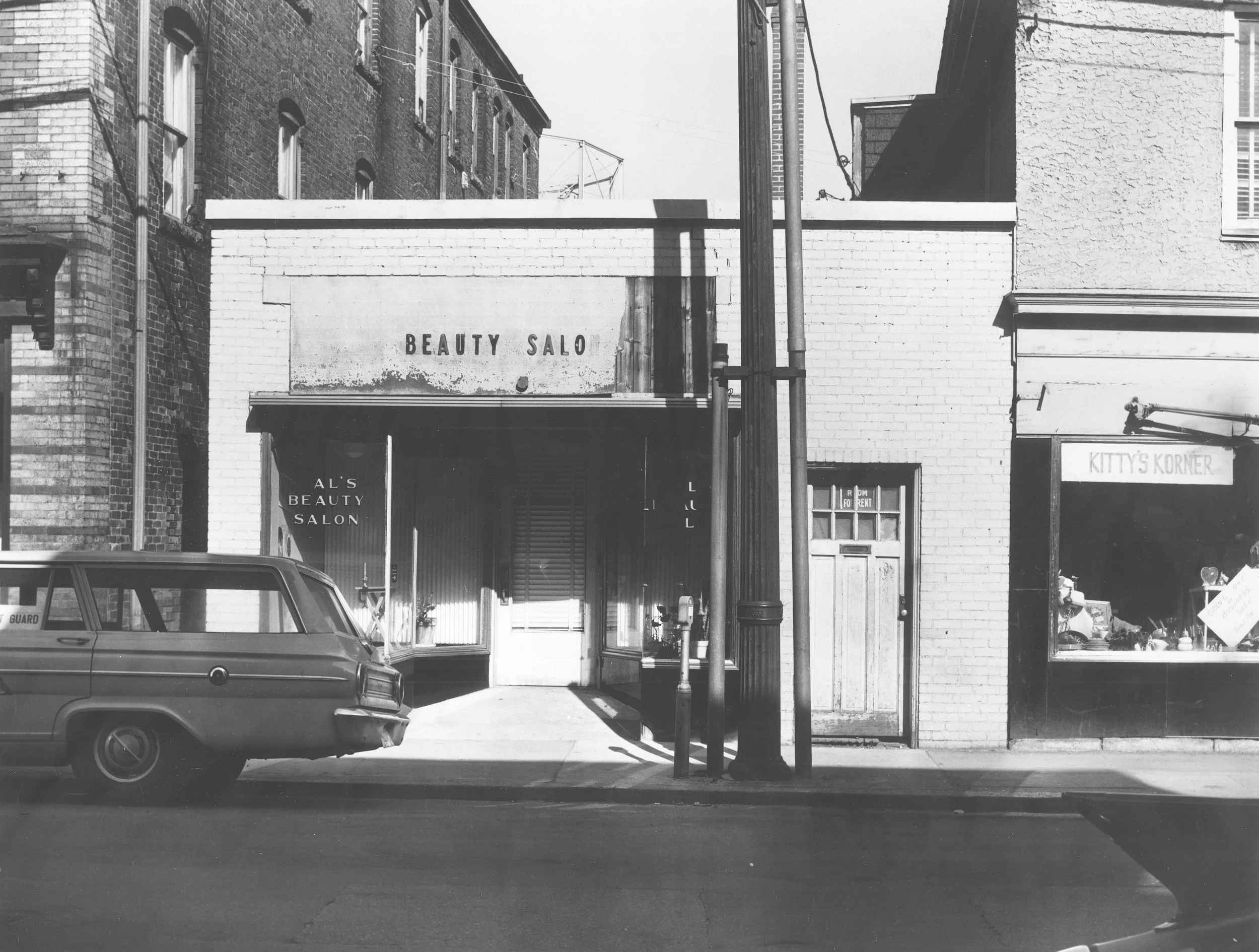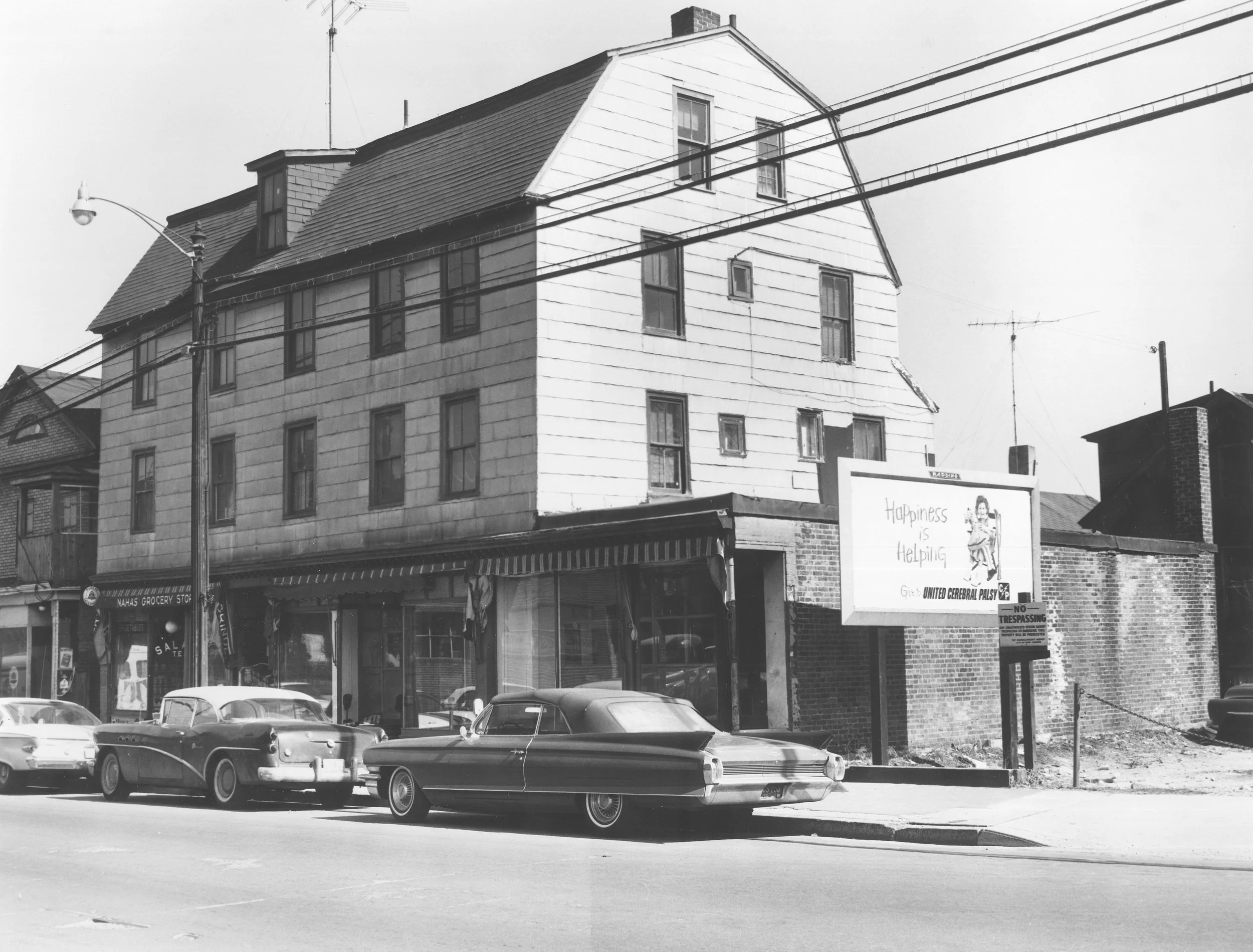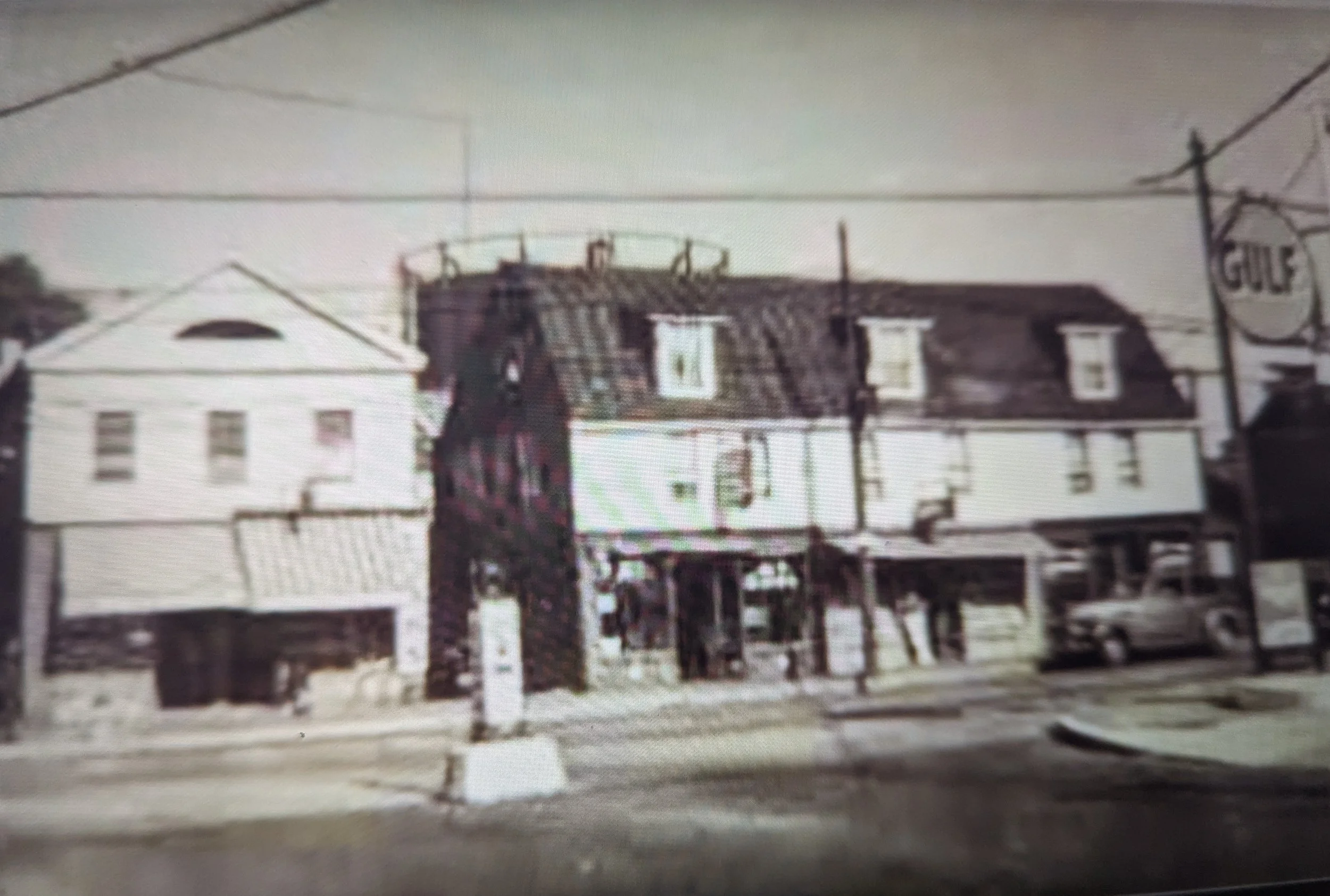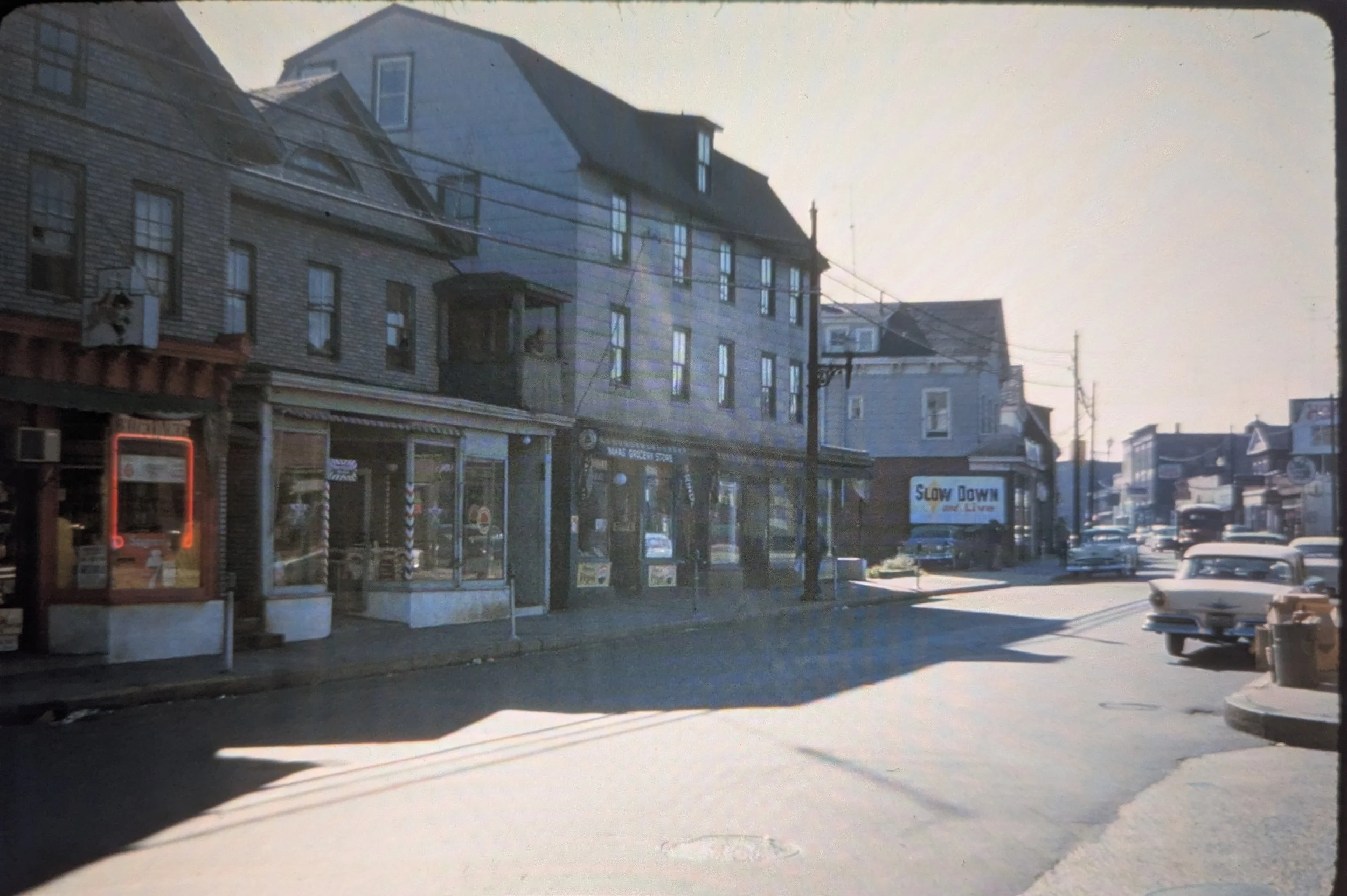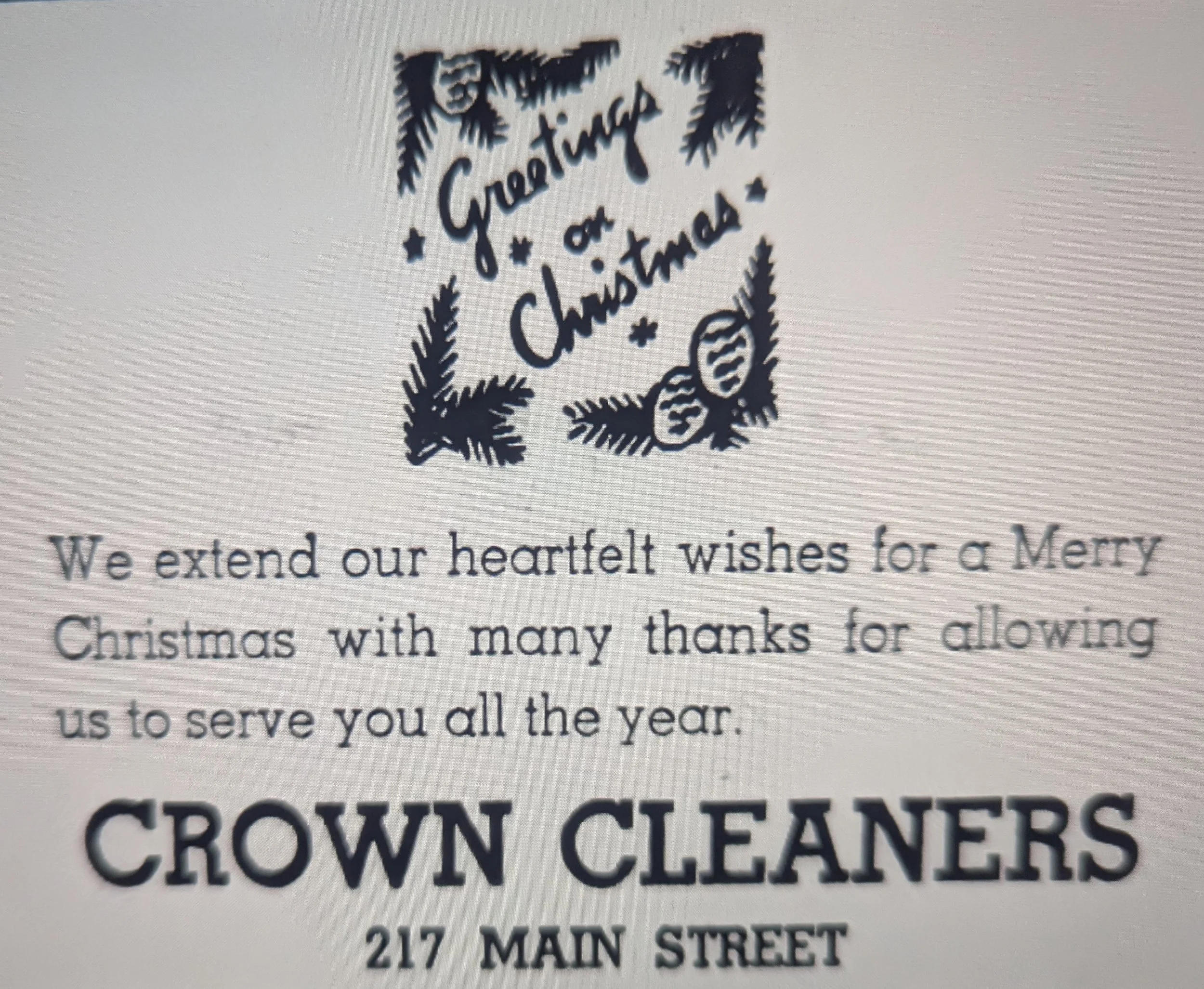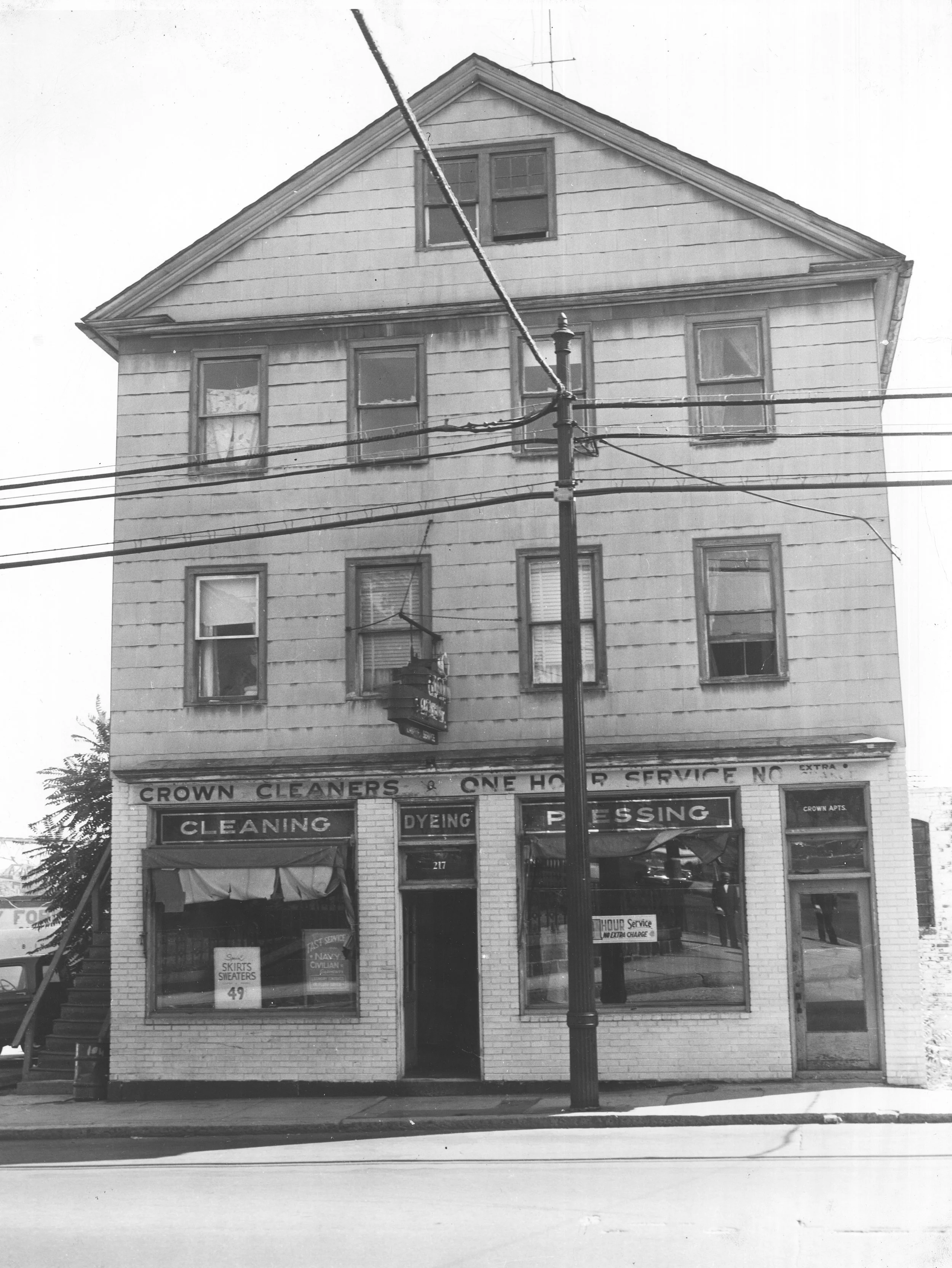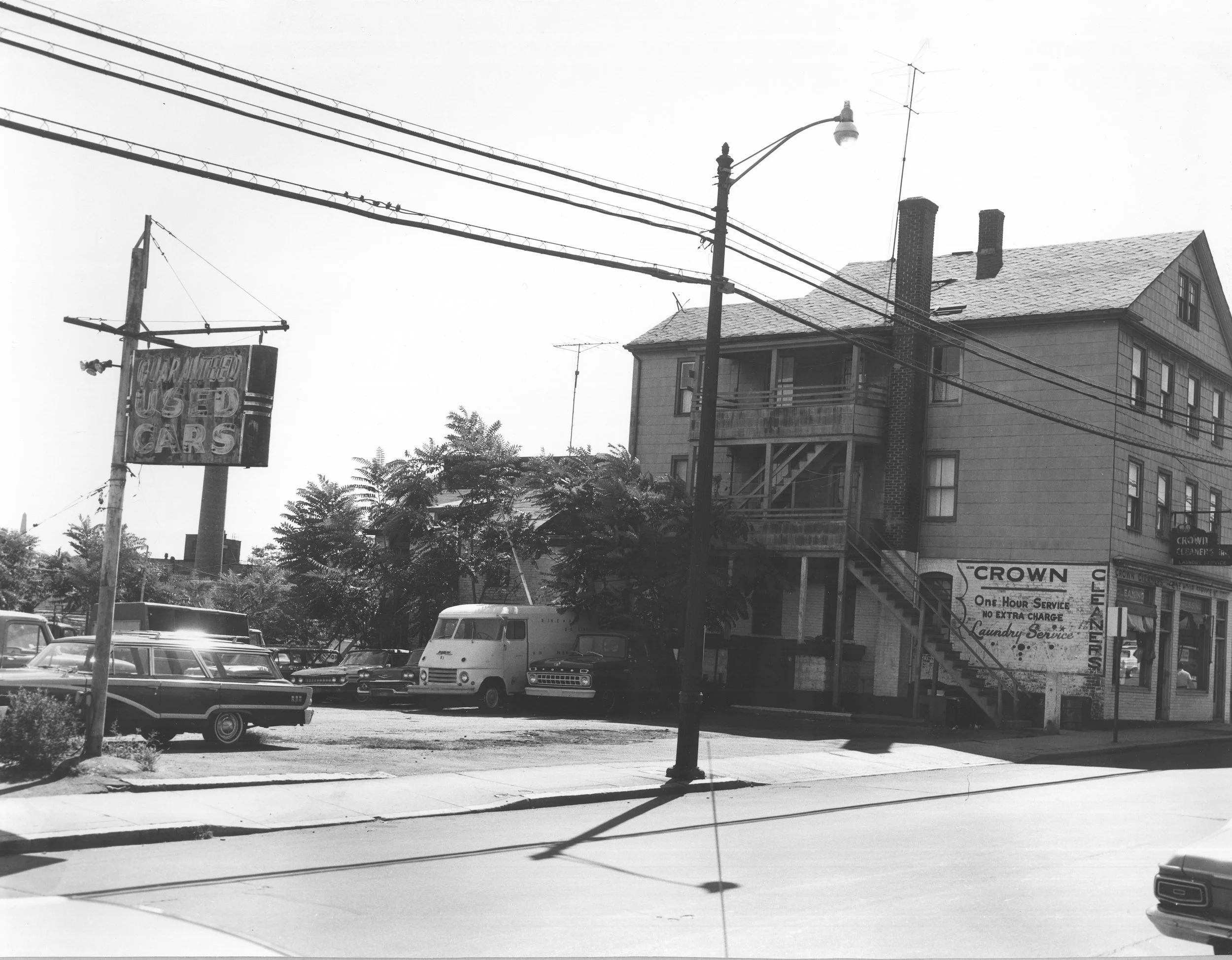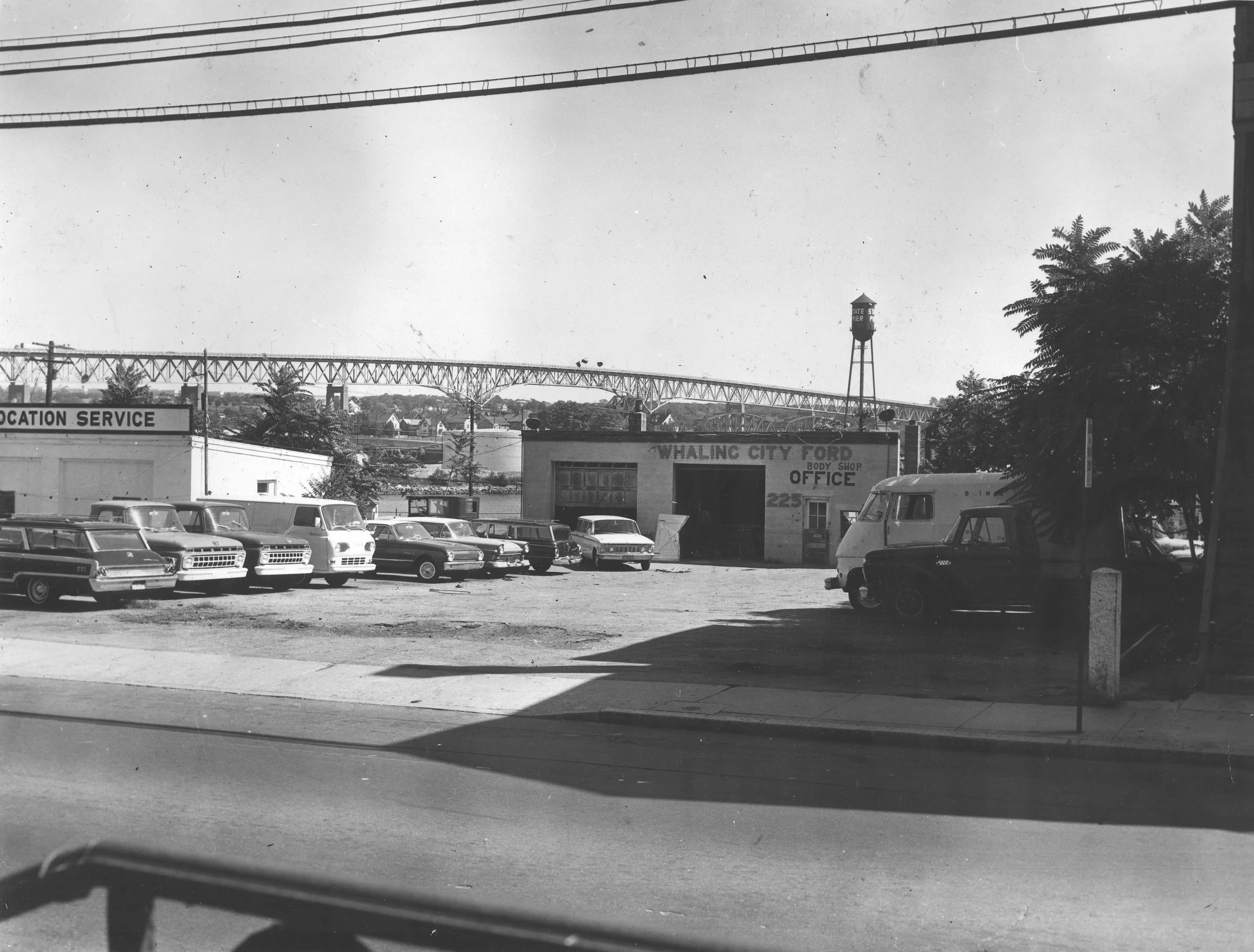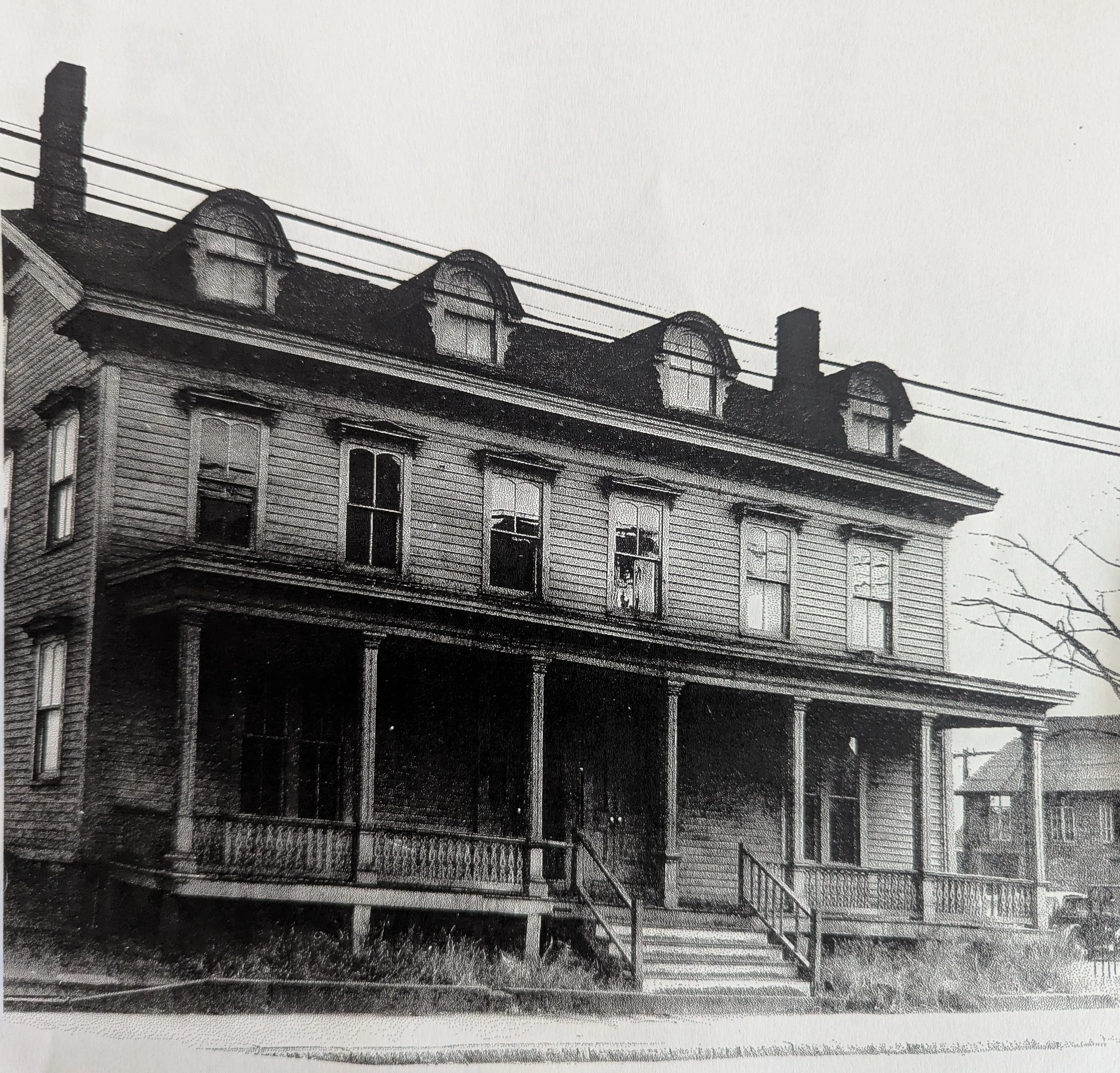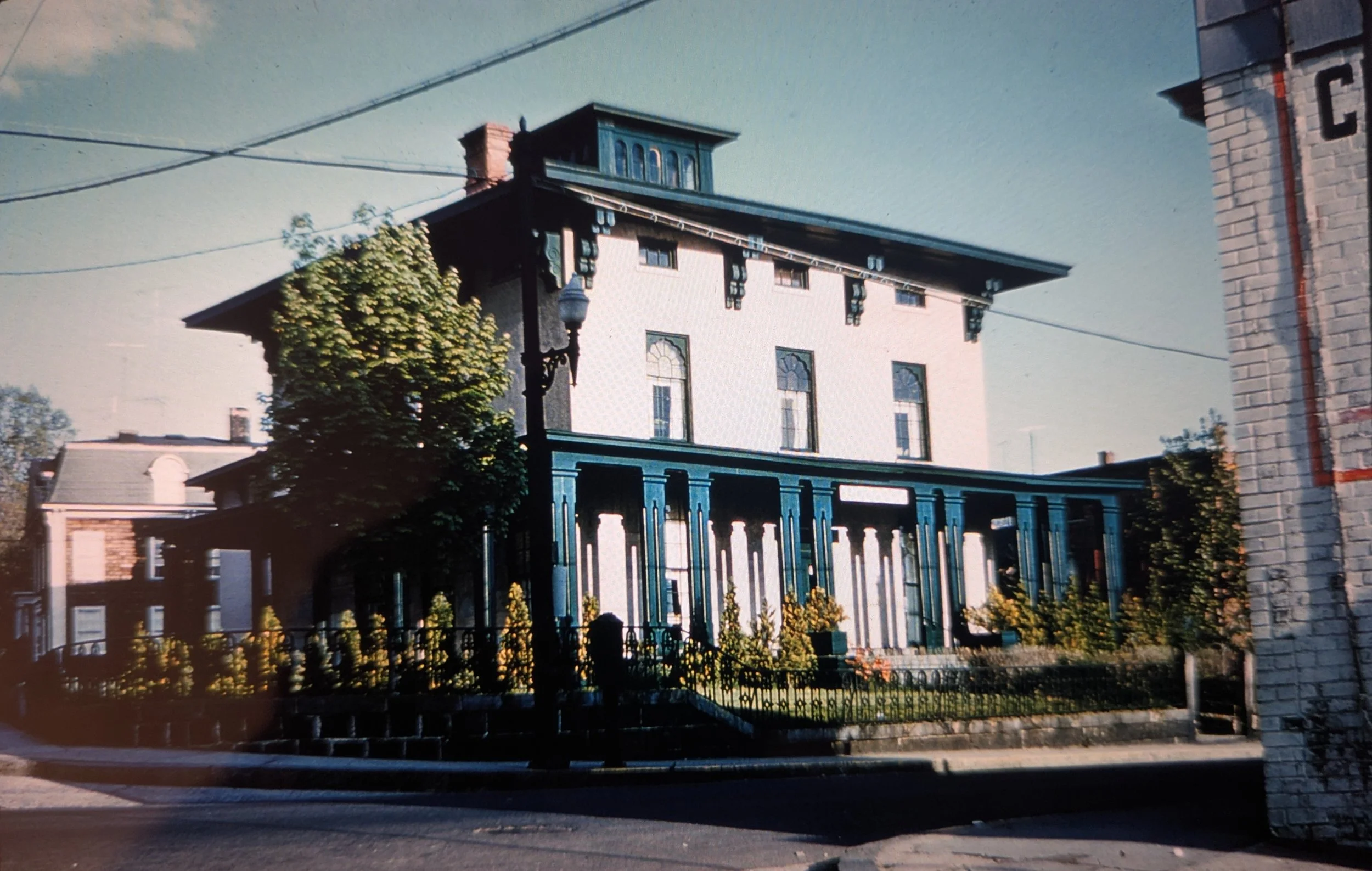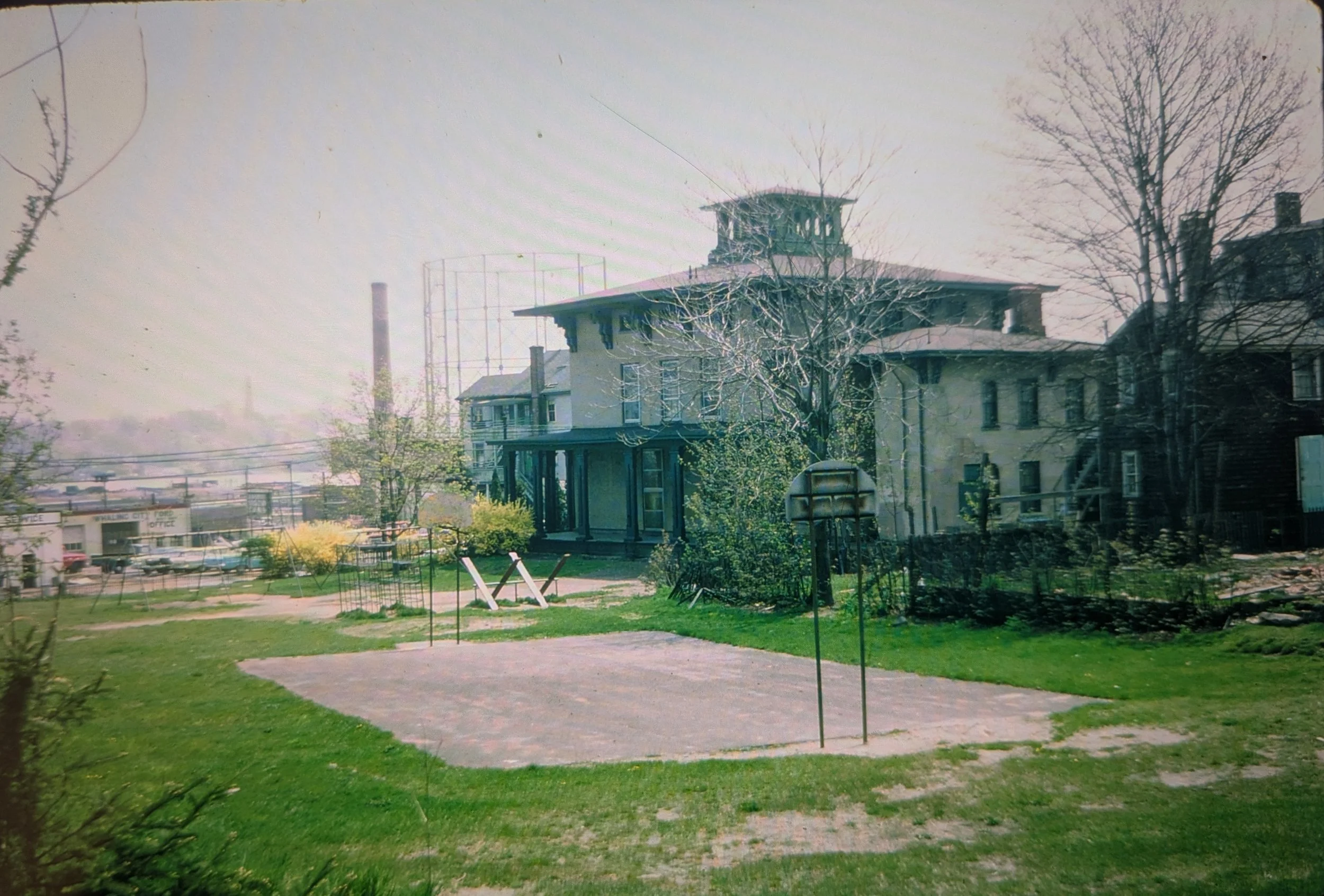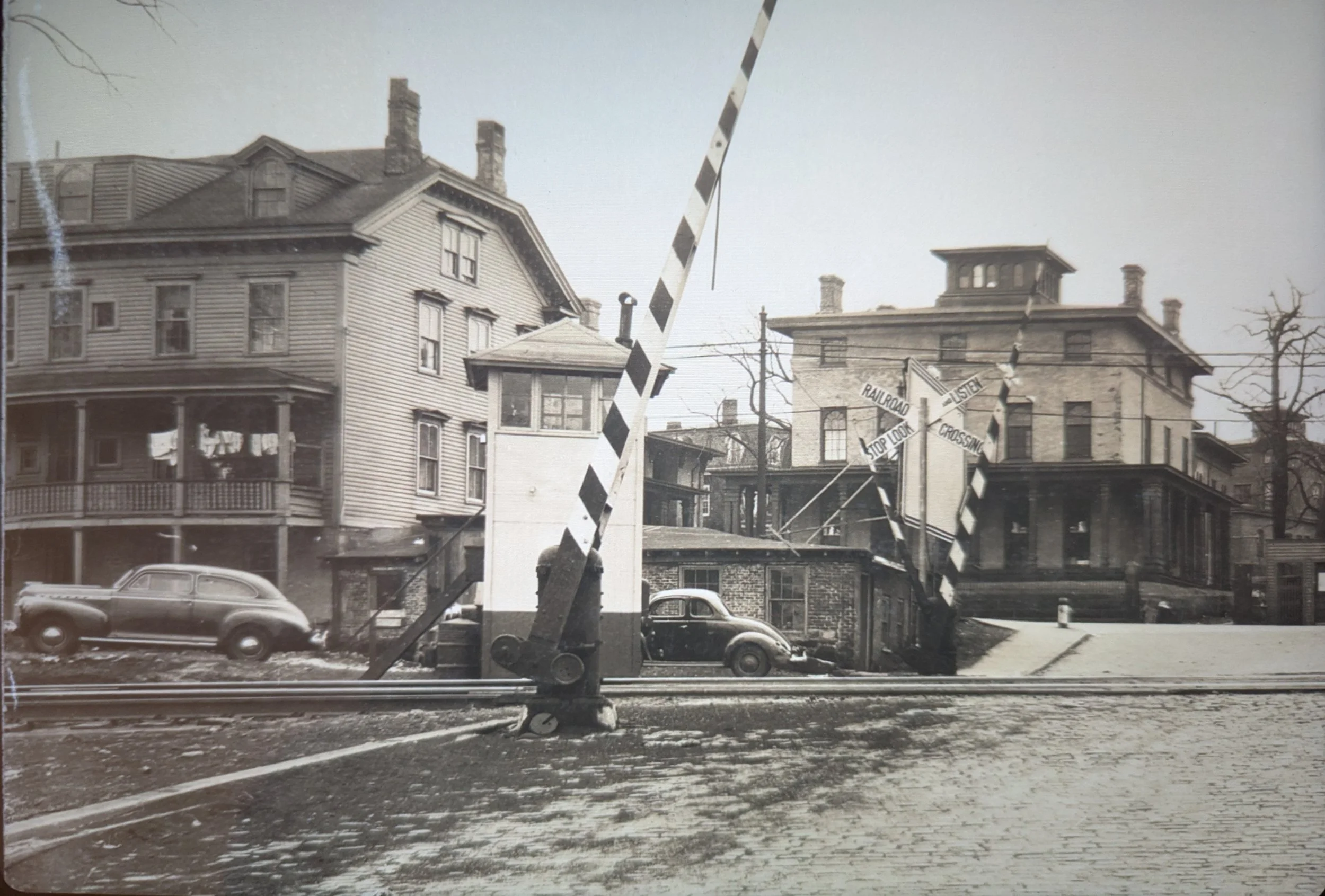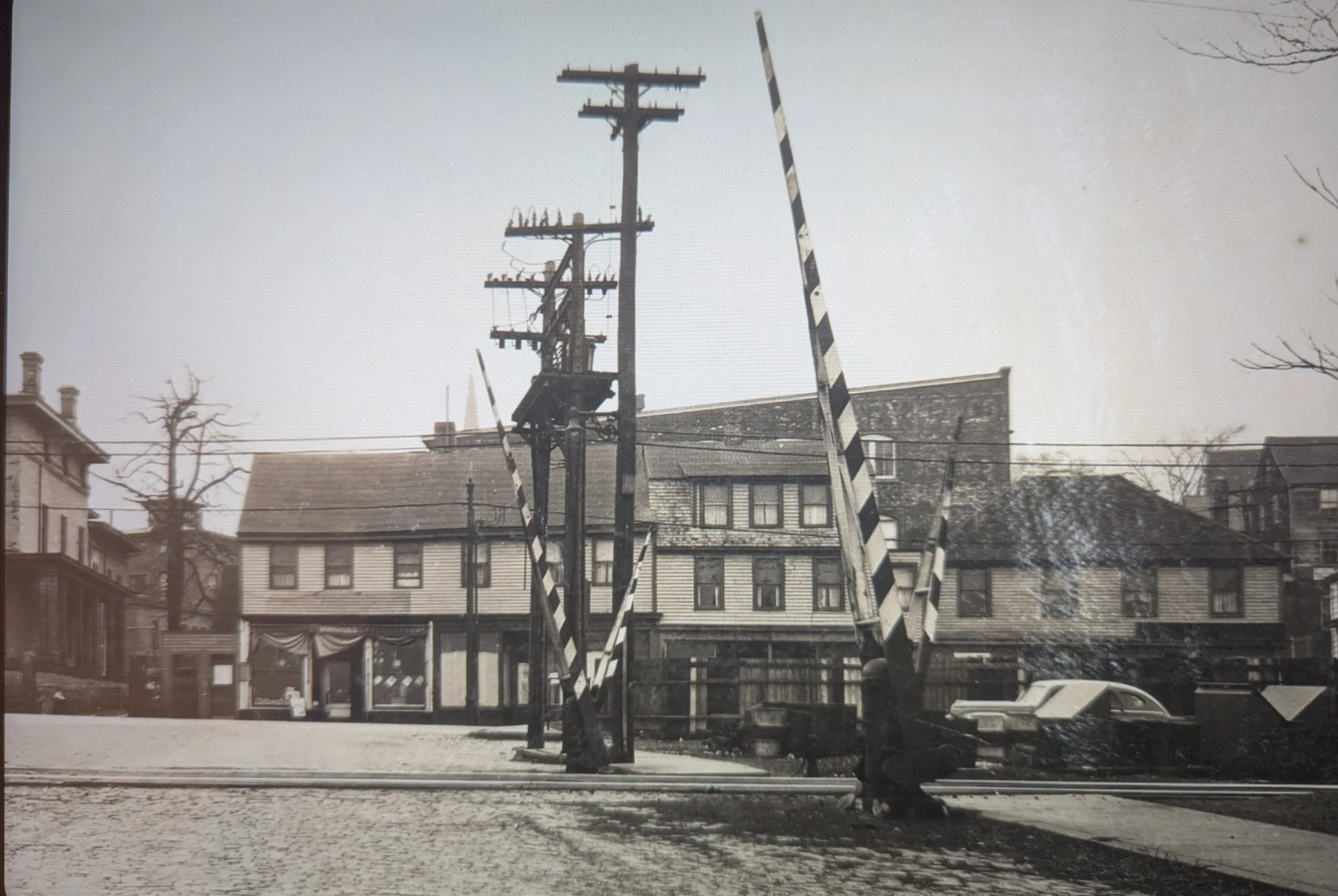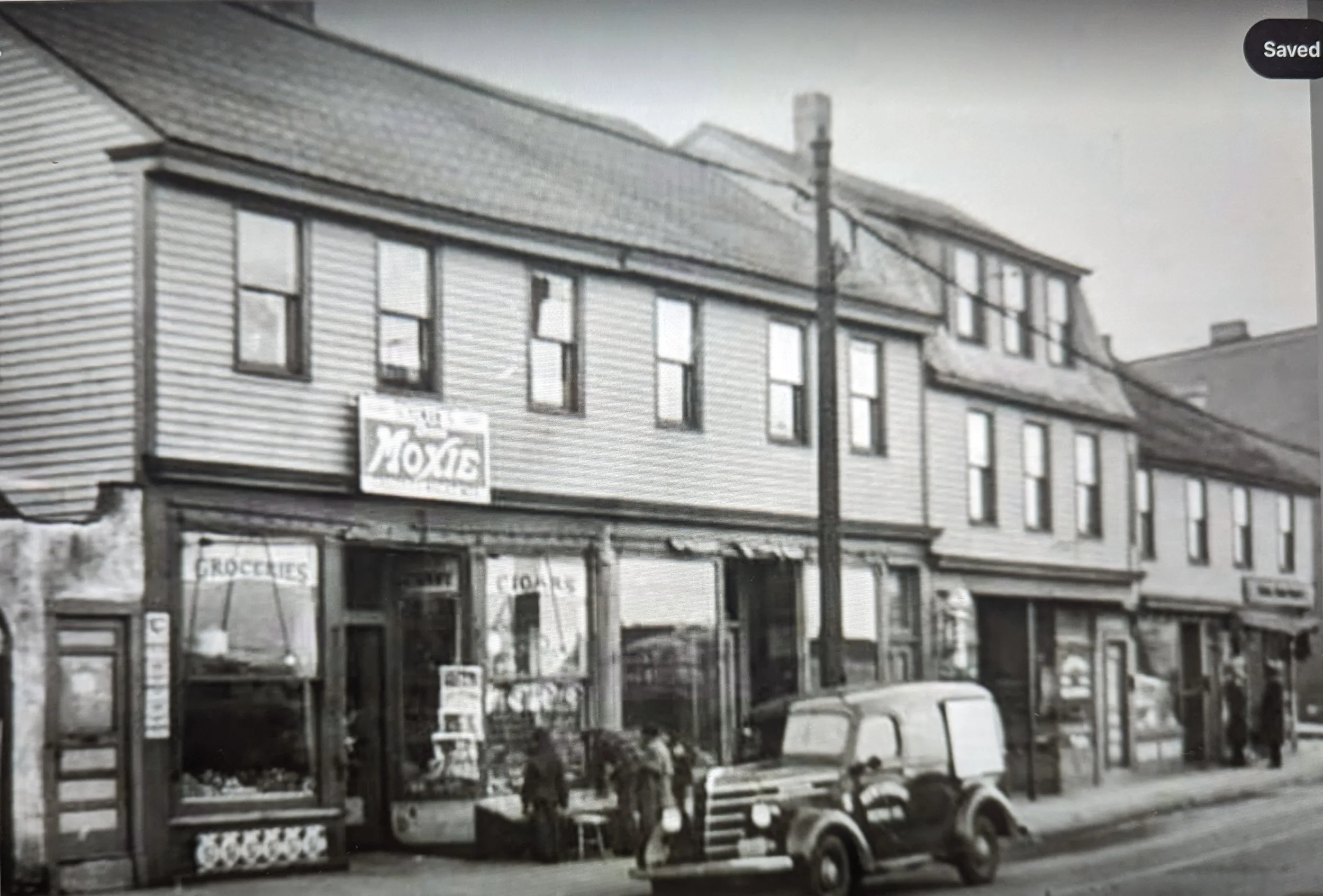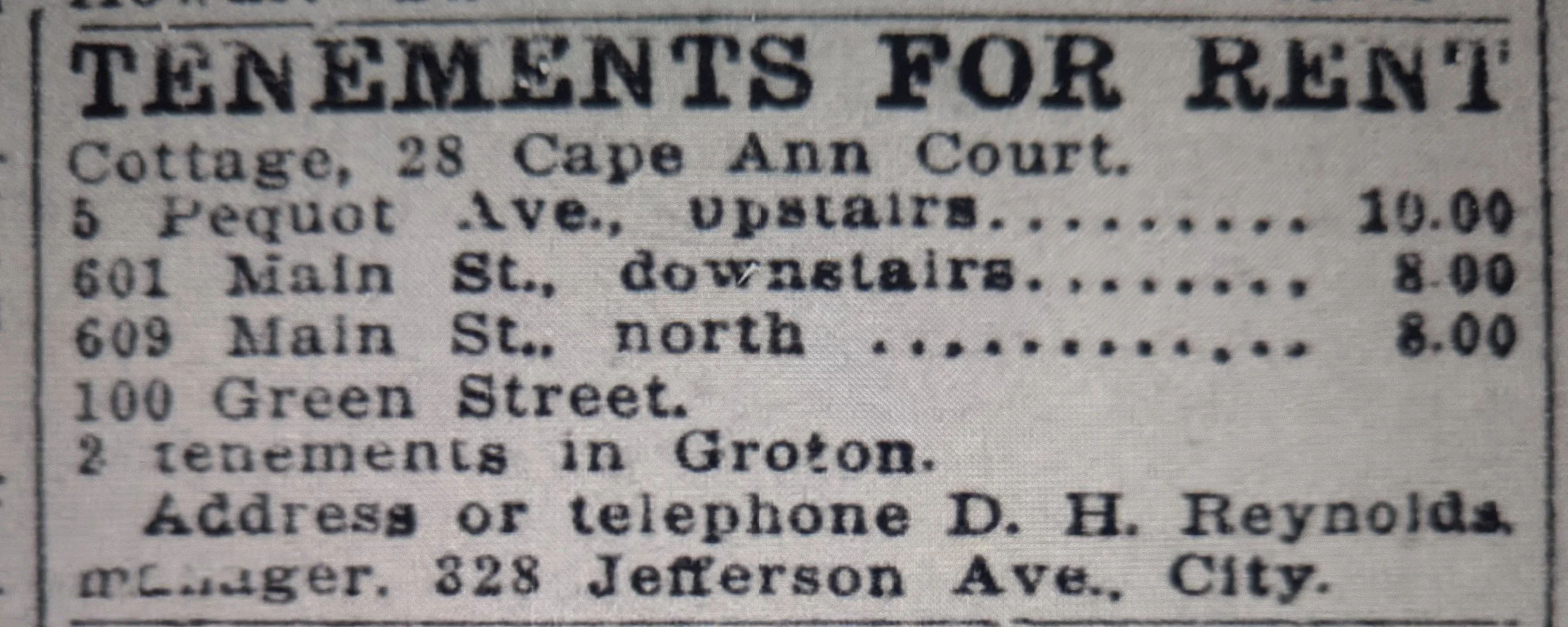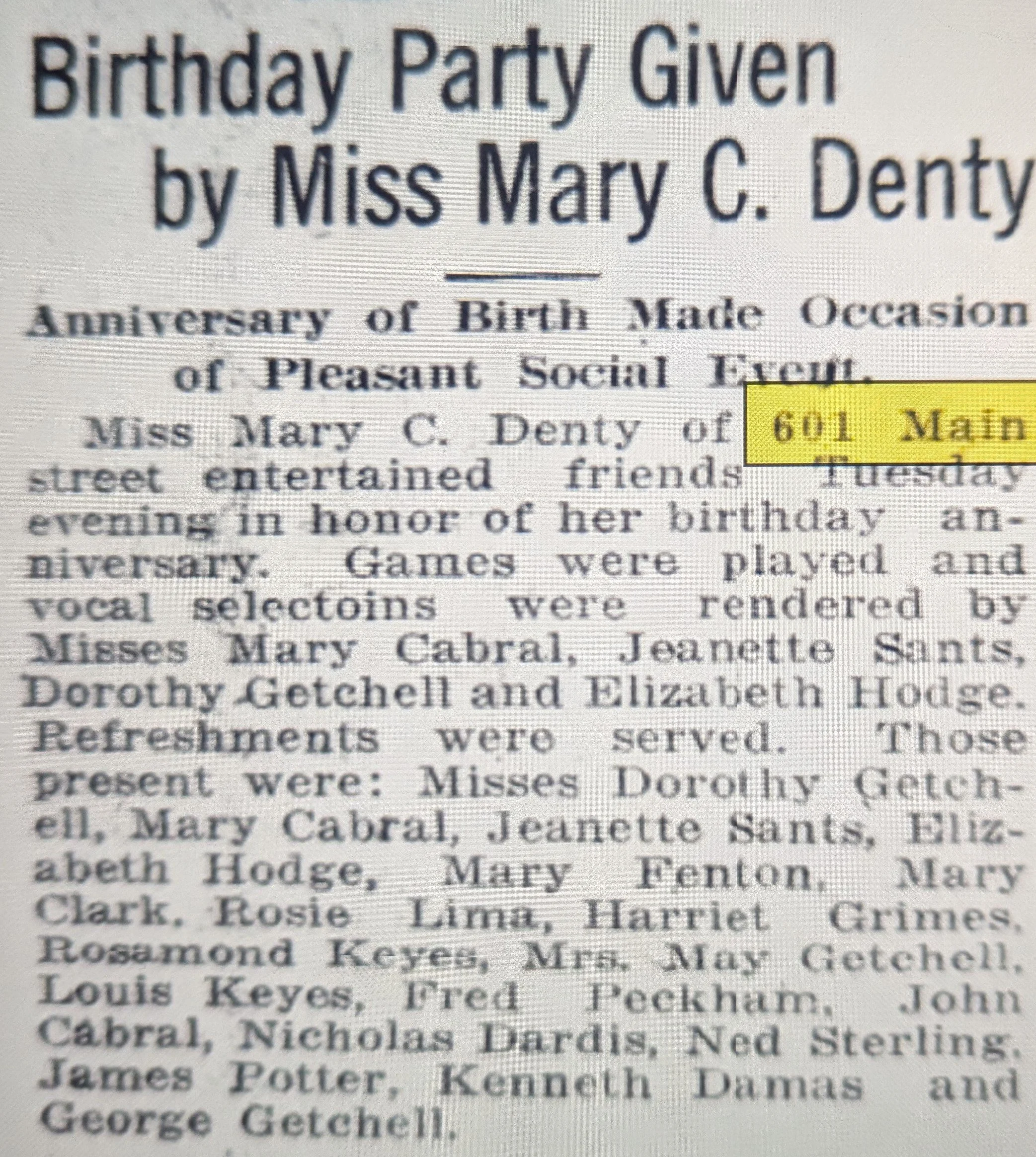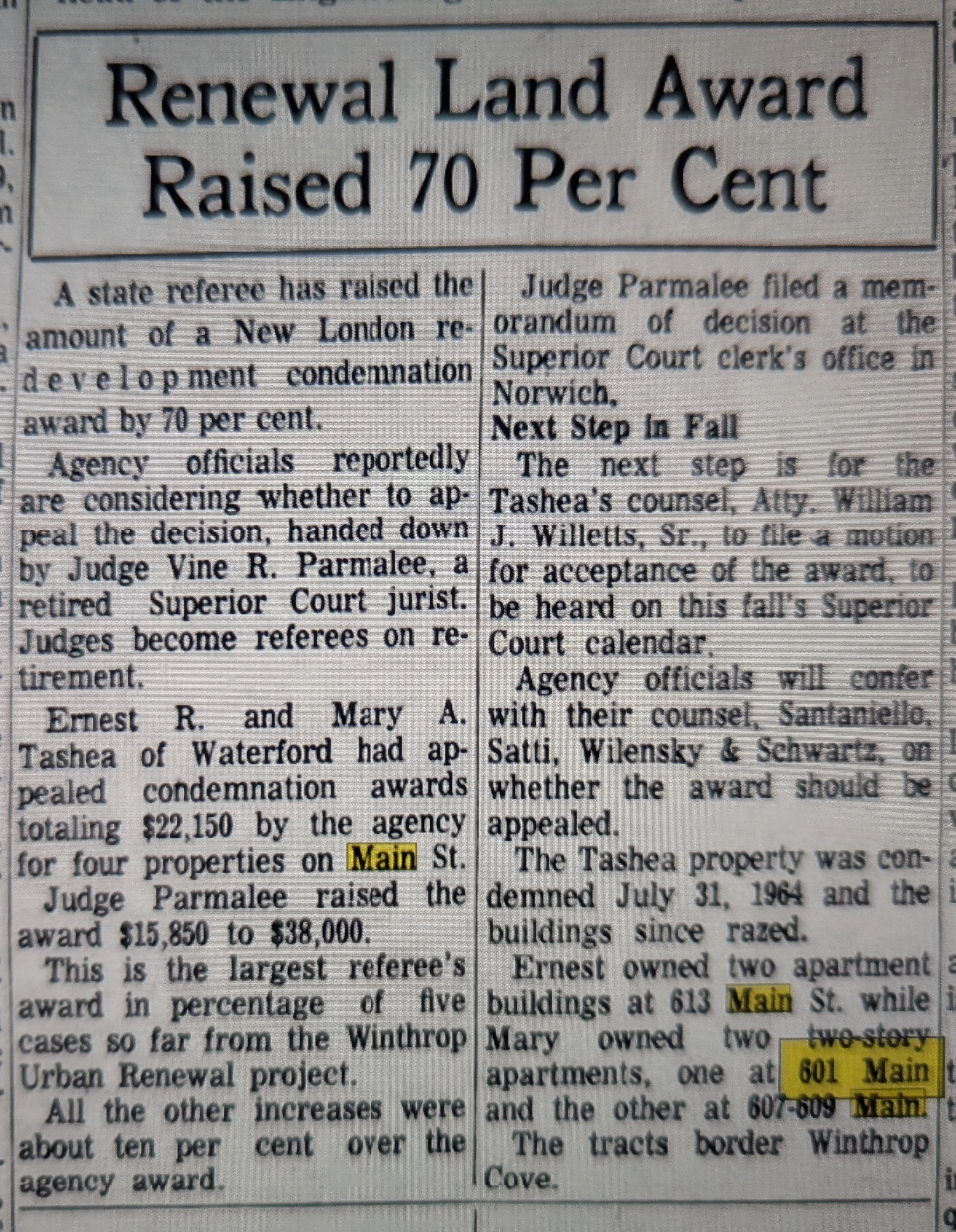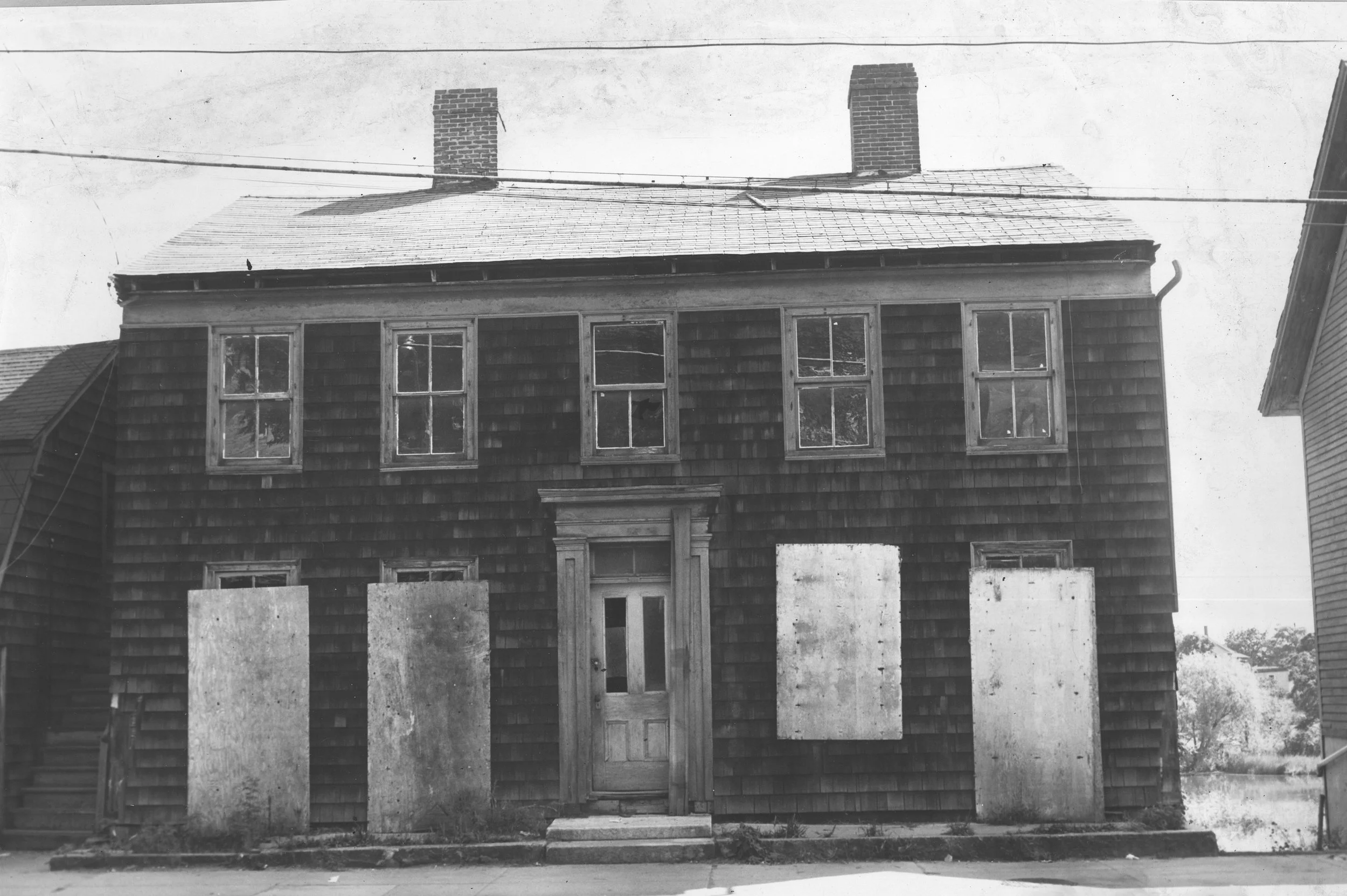Welcome to Main Street!
The end of prohibition at the opposite corner of State and Main Streets, circa 1933. The policeman would later get some added protection in a traffic booth with signage. When the booth later proved dangerous, public works removed it in the early hours of August 14, 1952. Woolworth’s is in the background. Caruso Music started at 25 Main Street and later moved to the Woolworth’s location where it stands today.
both pictures and display ad courtesy The Day
As late as 1875, the northeast corner of State and Main Streets was known as the Buttonwood Corner. This tree, also known as the Eastern Sycamore, can live between 200 to 500 years. Most likely planted in New London’s earliest days, the tree came to be a messaging board where notices of all sorts were posted. The tree was also referred to as New London’s Charter Oak. Now at the end of its life, this landmark was most likely chopped down, the firewood destined to the poor living nearby. Strickland & Co. provisions stands behind the tree.
As a side note, consider visiting The Buttonwood Tree at 605 Main Street in Middletown, less than an hour’s drive away. They offer good live music, libations, and nourishment.
Cheers, Buttonwood!
courtesy New London Public Library
In a future addendum, we’ll be covering Caruso Music.
Solomon’s Stationary is on the left and The Stork Shop is on the right. The year 1972 has come to an end with going out of business sales as evidenced by the display windows, and 1973 has arrived with a tall crane, clam shell, and a dump truck.
We will be covering the interesting story behind Solomon’s in a later addendum.
Hudson’s stood on the west side of lower Main Street diagonally across from The Day office building. In 1926 Esther and Morris Irwin opened their dry goods store at this storefront location in the Brainard Building. In 1955, when his father retired, Theodore took on full management of the store. By 1965, the writing was on the wall and Theodore shut down the family store after 55 years of operation. Today we do our trade mostly with large, multi-national corporations and not with local families. Will the next generation start to reverse this trend?
The Lionel Trains display ad appeared in The Day on November 8, 1951.
courtesy The Day
On November 1st, The Stork Shop closed for good with Mrs. Hendel posting special prices for the last time on October 16, 1972. Ironically on that same day, The Day reported a crime spree taking place that previous Saturday night. Herein a part of that report:
At some point in time later in the sixties, The Stork Shop changed hands an locations. Mrs. Symie Hendel, active in local theater and charities, became the new owner and 44 Main Street the new location. Some may remember Poudrier’s Jewelry being here in the early 60’s. They went out if business and vacated November 1, 1961. Sussler Realty took the spot for a few years before Mrs. Hendel moved in.
By redevelopment era standards, The Stork Shop had a good run during what were to be Main Street’s last years as a place and a name (Council changed the name to Eugene O’Neill Drive on October 20, 1972. The vote was unanimous. After the changes over the past decade, the street had indeed become a high speed drive-by).
It just so happens that the Surfers Drum and Bugle Corps Booster Club was looking for a location for their holiday season resale or thrift shop. Having been denied access to a vacant location on State Street by neighboring merchants, redevelopment offered them the Stork Shop space rent-free. The Surfers’ resale shop opened November 17th. Mrs. Arthur Nunes of the booster club is pictured left inspecting the goods.
courtesy The Day
And now enter the Beit Bros., originally at 14 Main Street (last tenant the Red Rose Restaurant from the late 40s to the early 60s), who later relocated and greatly expanded on the north corner of Main and Masonic, opposite the former Savings Bank of New London (later Citizens Bank).
from left to right…
Red Rose Restaurant, #14
Gorra‘s Fruit Market, #20
Kaplan‘s Travel Shop, #24
Solomon‘s Stationery, #30
The Hudson Shop, #34-40
The Stork Shop, #44
George Oldershaw, 1961
As it happens, The Stork Shop, like so many of the small businesses in downtown New London, has a bit of history…
Claire Cook, of 63 Church Street (now widened into a boulevard), opened the Stork Shop for mothers-to-be at 37 Green Street, couple of doors down from the Dutch Tavern in March of 1961, hence the display ad on the right from The Day on March 8th.
On the morning of March 10, 1963, officer John Shea, while on foot patrol, smelled smoke and called in the alarm. The fire had already been burning in the shop’s office for more than a few hours and when fire fighters entered the entire interior was being consumed in flames, fed in large part, by a recent delivery of store stock. The loss cost Mrs. Cook $7,500. The report in The Day did not mention any insurance. The building, most likely a gambrel roofed colonial house circa 1800, was later demolished. Thanks to the quick action of FDNL, the frame buildings on either side, also from New London’s colonial era, remained undamaged. Their footprint today is the parking lot between the Dutch Tavern and Golden Street.
Further up the street on the north corner of Main and John (now Atlantic), stood this majestic barn like stucco’d structure at 91 Main Street dating from 1820. The year is 1964, Paul’s (Araman) Restaurant and Kitty’s Bargain Corner are the last tenants. Mrs. Iona Besenbach offered furnished rooms on the floors above, living there with her husband Jenoe, a machinist by trade.
Al‘s (formerly Consuelo‘s(Cornish)) Beauty Salon is next door at #97. On July 18, 1964, two new stylists joined the salon.
Photos courtesy City of New London.
Display ad below courtesy The Day.
Two pre-revolutionary New London taverns, both with gambrel roofs…
The three dormer opposite Church Street and Burdick‘s Gulf Station was the Fox and Grapes at 153-159 Main Street opposite Church Street and Burdick‘s Gulf Station. The Sons of Liberty met here. In the sixties the building housed Moutran (George) Realty at 153 and Maynard‘s (Jack) Grocery at 157. Rising above is the Connecticut Gas Co. tank on the waterfront. Neighbor on the left is John‘s Sandwich Shop at 165. John Blanos ran the place which was more of a restaurant.
courtesy the Public Library of New London
This second colonial tavern with the single dormer standing at 189-197 Main Street was the Red Lion. The Edmondo Bonacci family ran a shoe and clothing business at 189-193 with furnished rooms available at 195. Solomon and Frieda Nahas managed a grocery store at 197.
courtesy City of New London
This down street view from Federal Street takes in the Jiggs (neon) Package Store at 207 Main. Think of Maggie and Jiggs from the comic Bringing up Father, if you are old enough. Mrs. Mary Joyal was the permittee. Next door at 201 is the barbershop of Mr. George Telage with the Charles Lee Laundry occupying the small storefront at 199. Above, sitting in the catbird seat, is most likely Mr. Enrique Blanco at 203, relaxing and watching the world go by.
courtesy George Oldershaw, 1961
We are on the northeast corner of Main and Federal at 215-219 Main Street, home of Crown Cleaners and Crown apartments and owned by the Gottlieb brothers, William and Albert.
courtesy City of New London, 1964
courtesy The Day, 12/24/51
But… do you know what stood on this southeast corner of Main and Hallam Streets before there was a Whaling City used car lot?
There was this 4-dormer beauty with the full-length front porch at 243-245 Main Street. Hallam Street is on the left (north), just out of this picture which dates from the mid-thirties. In 1930, the Salvation Army used this house as their home for men.
In the late forties, the house was dismantled, the contractor selling the building materials through a classified ad in The Day. During the fifties and early sixties the lot sold used cars, with Navy sailors being among the better customers. Whaling City Ford was the last owner.
At some point in the near future, we‘ll look at the history of this landmark.
courtesy the New London Public Library
to be continued across the street…
This is a work in progress.
Stay tuned for captions and more images.
This headline appeared on page seven of The Day on August 9, 1944. After nearly three years of a war-time economy with at capacity manufacturing and a worker housing shortage, many older apartment buildings and duplexes were crowded and showing their age and limitations from lack of maintenance and the wear and tear of daily living. Though this survey covered the entire city, I have limited this posting to the Main Street neighborhoods. Please remember that this is the mid-forties. Much of the housing remained in neglected condition as the post war economic emphasis shifted to car-ownership and a Cape-style home with a yard in the suburbs. This continual decline in some of the Main Street neighborhoods fueled the drive for redevelopment, culminating in a referendum win for its supporters on “R Day”, April 30, 1962.
The report as submitted by Dr. Benjamin Pennell, health officer, at the council’s request, follows:
“The building survey now in progress has, up to the present, included 107 structures which contain 644 family living units, as well as a large number of rooms used for lodging only. Of the 107 buildings inspected, 22 are occupied by colored persons entirely or mixed white and colored families. These 22 buildings contain a total of 110 dwelling units of which 68 were available for inspection at the time the buildings were visited. Seven of these dwellings are in buildings considered entirely satisfactory. Five are in buildings requiring only minor repairs. 35 are in buildings with one or more major defects such as improper exits, serious structural or plumbing defects or serious sanitary defects. 63 dwelling units are in buildings which are substandard beyond the point of economic rehabilitation. This does not mean that all of these dwellings are unfit to live in at the present time, it is felt that they should eventually be replaced by new structures, or extensive repairs should be carried out.
“The following tabulations give locations of buildings at which conditions were found which are usually considered as contributing to substandard living. It will be noted that some of these undesirable conditions are primarily the fault of tenants, while others are due to lack of maintenance by the landlord.
Shared toilets — 28 Hill Street, 2; 32 Hill Street, 2; 243-245 Main Street, 2; 579 Main Street, 2; 587-591 Main Street, 2; 62-72 Douglass Street, 1;
Overcrowding — 243-245 Main Street, 1; 306-312 Main Street, 1; 579 Main Street, 1;
Unsatisfactory Toilets — 28 Hill Street, 2; 243-245 Main Street, 1; 306-312 Main Street, 1; 559 Main Street, 3; 579 Main Street, 4; 587-591 Main Street, 2; 192-194 North Bank Street, 1; 222 North Bank Street, 2; 62-72 Douglass Street, 1;
No Bathing Facilities — 28 Hill Street, 1; 31 Hill Street, 1; 8 School House Lane, 5; 243-245 Main Street, 1; 294 Main Street, 1; 306-312 Main Street, 1; 559 Main Street, 3; 570 Main Street, 2; 587-591 Main Street, 2; 192-194 North Bank Street, 1; 222 North Bank Street, 3; 62-72 Douglass Street, 2.
Vermin (rats, roaches, bedbugs) infestation — 20 Hill Street, 1; 28 Hill Street, 1; 8 School House Lane, 1; 243-245 Main Street, 1; 294 Main Street, 3; 306-312 Main Street, 2; 559 Main Street, 3; 579 Main Street, 5; 587-591 Main Street, 2; 192-194 North Bank Street, 3; 222 North Bank Street, 2.
Unsatisfactory sanitary conditions in dwelling units — 20 Hill Street, 1; 28 Hill Street, 1; 243-245 Main Street, 1; 306-312 Main Street, 2; 360 Main Street, 1; 559 Main Street, 3; 579 Main Street, 3; 587-591 Main Street, 2; 192-194 North Bank Street, 3; 222 North Bank Street, 3.
Yards, premises or structures in need of clean-up — 20 Hill Street, 28 Hill Street, 243-245 Main Street, 294 Main Street, 306-312 Main Street, 360 Main Street, 559 Main Street, 579 Main Street, 587-591 Main Street, 192-194 North Bank Street, 222 North Bank Street, 62-72 Douglass Street.
Inadequate means of egress — 8 School House Lane, 306-312 Main Street, 579 Main Street, 587-591 Main Street, 222 North Bank Street.
Dangerous Rails, Porches or Stairways — 20 Hill Street, 28 Hill Street, 33 Hill Street, 243-245 Main Street, 294 Main Street, 306-312 Main Street, 360 Main Street, 559 Main Street, 579 Main Street, 587-591 Main Street, 222 North Bank Street, 62-72 Douglass Street.
*****************************************************************************************
“The shortage of desired housing has been aggravated by war conditions and some relief may be expected in the post war period. There are, however, many old buildings that through long use and lack of maintenance have deteriorated to a point where living quarters are substandard.
“There appears to be a definite need for a coordinated program of all city agencies to consider means of stimulating new construction, as well as requiring owners of substandard property to make repairs necessary to bring buildings up to compliance with the health and housing laws. Such a program should include all housing and not be confined to dwellings occupied by a particular race.
“There are many unfit buildings occupied by white families and these people are also entitled to consideration.
“In closing we wish to emphasize that much can be done by individual families to improve their own living conditions through the exercise of ordinary care in maintenance of sanitation and good housekeeping,”
601 Main Street was one of many houses that backed onto Winthrop Cove. These clippings from The Day newspaper give us a brief glimpse of this property as a home and business opportunity.
601 as a rental property, courtesy The Day, in 1910.
A child‘s birthday party on St. Patrick‘s Day, 1916.
Renewal Land Award (compensation) article courtesy The Day, 7/23/1965.
601 Main not long before demolition in 1964, note tree on far side of Winthrop Cove. Courtesy City of New London.
